PROTESTERS EN ROUTE TO TRIAL
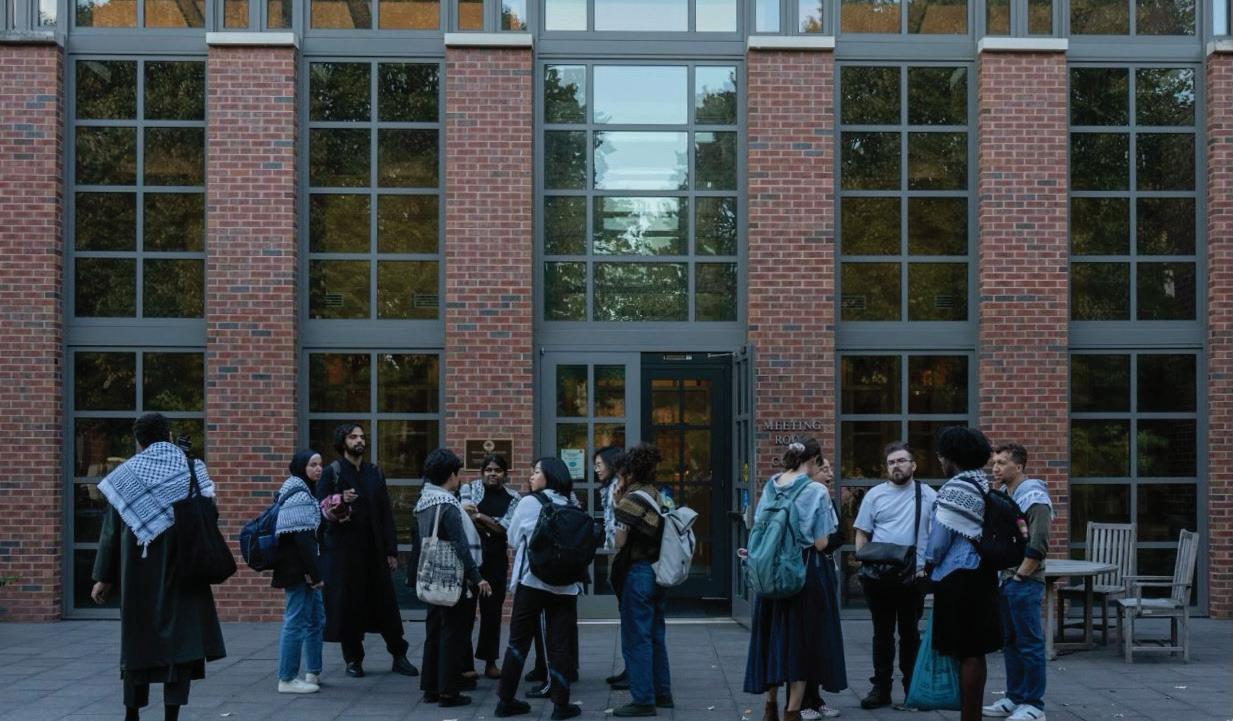


By Miriam Waldvogel & Olivia Sanchez
Plea deals for six of the 13 University affiliates arrested for occupying Clio Hall in April were rejected by Princeton Municipal Court Judge John McCarthy III ’69 on Tuesday. The seven other protesters have already opted to not take the deal and proceed to trial.
The agreement, proposed by Municipal Prosecutor Christopher Koutsouris, would have entailed a guilty plea to a municipal noise
AFFAIRS
ordinance, avoiding the current charge of defiant trespassing. McCarthy took issue with an allegation from witnesses in Clio that one protester told staff in the building that they had 60 seconds to leave, first reported in the Princeton Alumni Weekly.
“I don’t think it’s an appropriate factual basis [for] what you did,” McCarthy said to Sara Ryave ’24, the first defendant to request a plea deal. “I am not going to grant this plea agreement. Sorry. I admire your courage, I admire your conviction.”
“I think it is wildly bizarre to reject this deal on this supposed basis of ‘fairness and justice,’” Brooklyn Northcross ’24, who was also planning to take the deal, wrote to The Daily Princetonian. Northcross noted that she no longer lives on the East Coast after graduating in the spring. She attended Tuesday’s hearing over Zoom, alongside Khari Franklin ’24 and Kristal Grant ’24, who both hoped to enter plea deals as well.
While McCarthy rejected the deal at the conclusion of the hearing,
By Vitus Larrieu & Isabella Dail Staff News Writers
At the height of pro-Palestine protests last spring, hundreds of people surrounded Clio Hall as 13 protesters occupied an office inside, ending with the arrest of all 13 inside the building.
Now, those 13 arrestees are all facing charges of defiant trespassing in Princeton Municipal Court, after Judge John McCarthy III ’69 denied the plea deals of six defendants during a Tuesday hearing. Two other students who were arrested after putting up tents on the first day of the “Gaza Solidarity Encampment” protest walked away on Tuesday with a $100 fine, which was waved by McCarthy.
During Tuesday’s hearing, McCarthy questioned protester Sara Ryave ’24 under oath regarding what happened inside Clio Hall from the protesters’ perspective.
Over the course of about 15 minutes, Ryave confirmed previously reported information while divulging new information under oath. Here are the highlights.
Protesters sought a meeting with admin Ryave confirmed under oath that the initial goal of the protesters was to meet with Dean of the Graduate School Rodney Priestley to discuss divestment. She also said that when they found Priestley was not in his office, protesters decided to barricade themselves inside and start
the sit-in protest that led to their arrest.
“When he was not there, we chose to stay inside of his office, and we asked University staff members to leave,” Ryave told the courtroom.
As The Daily Princetonian reported at the time, protesters occupied Priestley’s office to pressure negotiations with administration on divestment from Israel. At that point — five days into the encampment — University administrators had not yet met with protesters to discuss their demands nor made any statement about their stance on divestment. The University has since agreed to move towards formally considering divestment,
GRADUATE SCHOOL
By Olivia Sanchez & Miriam Waldvogel Associate News Editors
After a series of court appearances over three months, the two graduate students arrested in the first moments of Princeton’s “Gaza Solidarity Encampment” pled guilty to a municipal noise ordinance on Tuesday.
By accepting the deal offered by Municipal Prosecutor Christopher Koutsouris, they will each pay $33 in court fees. Judge John McCarthy III ’69 waived the accompanying $100 municipal noise ordinance fines for each person.
“My clients just want to move on with their lives,” said Omar Qadeer, the attorney representing the two students, Hassan Sayed GS and Achinthya Sivalingam GS ’24.
Sayed and Sivalingam were arrested in McCosh Courtyard for erecting tents during the beginning of the “Gaza Solidarity Encampment” on the morning of April 25. While several protesters
attempted to set up tents, and others chanted and banged on buckets — Sayed and Sivalingam set up two tents. Sayed is a Ph.D. candidate in the economics department, and Sivalingam has since graduated.
The plea deal changed their charge from defiant trespassing — a low-level petty disorderly persons offense — to a violation of a Princeton municipal ordinance about “disturb[ing] the public peace and quiet by loud, boisterous, or vulgar conduct.”
“What’s alleged is that the conduct disturbed the peace,” Koutsouris clarified to the court.
In New Jersey, a plea agreement must have a “factual basis,” and judges can reject a deal if they determine that it is too lenient.
McCarthy asked Sayed and Sivalingam a series of questions to determine whether there was a factual basis for their plea agreement to be based on a noise ordinance. Koutsouris told McCarthy,
See FINES page 2
This week, The Daily Princetonian returns to the Fall of 1970, when an effort to engage alumni financially and verbally during unprecedented upheaval inside the Orange Bubble was taking place. In a time of heightened political tension, students, alumni, and University staff met in an attempt to revive the University’s Annual Giving campaign. Princeton’s financial power is still a topic of conversation today — and amid current conflicts in the Middle East, some alumni are reflecting on how their donations relate to broader issues in society.
am not going to grant this plea
Sorry.”
Continued from page 1
Koutsouris — who helped negotiate the deal — noted that the deal is not officially off the table.
“I cannot speak for the Judge, but I would imagine that the Judge will contemplate the plea agreement and perform some independent legal analysis and make a determination whether he will accept the plea agreement advanced for the Defendant(s),” Koutsouris wrote to the ‘Prince.’
Ryave, who was put under oath by McCarthy and faced extensive questioning by luck of the draw, said someone had asked the staff to leave, but did not confirm the countdown. She also said that the protesters entered Clio seeking a meeting with Rodney Priestly, the Dean of the Graduate School.
Continued from page 1
“[We] felt that our best way that we could use our voices was to pressure the University to divest its financial holdings from Israeli companies and Israeli institutions,” she explained regarding their decision to occupy Priestly’s office.
“When he was not there, we chose to stay inside of his office, and we asked University staff members to leave,” she said.
After answering McCarthy’s questions for approximately 15 minutes, Ryave was embraced in a hug by her fellow defendants.
Aditi Rao GS, another student arrested at Clio, also denied that an explicit countdown had been given.
“Many of us might remember somebody saying that the staff should leave the space, but it was never a directive about time,” she said in an interview with the ‘Prince.’
McCarthy expressed dismay about potentially approving a plea
deal for the person who may have given the countdown. He said that person who gave the countdown “expects to have a plea deal for a noise ordinance. That is not coming from this court.”
Ryave, Northcross, Franklin, Grant, Ariel Edelman GS, and Christian Silva, a student at the Princeton Theological Seminary, all requested that their cases be resolved with the deal. Rao, along with Christian Bischoff GS, Hellen Wainaina GS, Andres Blanco Bonilla ’24, Jacob Neis GS, Sofia Menemenlis GS, and postdoctoral researcher Sam Nastase opted not to take a deal, instead having their cases proceed to trial.
McCarthy’s rejection of the six protesters’ pleas came after multiple hours of procedural debate over attorney Aymen Aboushi’s ability to represent all 13 defendants. Under New Jersey court regulations, lawyers must secure permission from
the court to represent multiple defendants via a motion made in the presence of all the clients. Additionally, a court professional conduct rule mandates that attorneys must inform their clients of potential conflicts of interest that come with representing multiple individuals.
After back-and-forth between Aboushi and McCarthy about the matter, each of the 13 defendants answered a series of questions from the judge to confirm that Aboushi informed them of the issues that could arise from him representing multiple defendants.
The hearing then proceeded to the question of a plea deal, finishing just before 6 p.m. after a 2:30 p.m. start time.
“These drawn out proceedings have left some of us who have graduated or are soon to graduate from Princeton with little reasonable option but to seek a plea agreement to
resolve the case and move on with their lives,” the arrested students wrote in a joint statement to the ‘Prince.’
The University declined to comment on the outcome of the hearing. McCarthy is expected to reject the plea deals at the pre-trial conference, currently set for Nov. 5. The six protesters will have to decide whether to plead guilty to the original defiant trespassing charge, successfully negotiate a different deal, or go to trial.
Miriam Waldvogel is an associate News editor and the investigations editor for the ‘Prince.’ She is from Stockton, Calif. and often covers campus activism and University accountability.
Olivia Sanchez is an associate News editor for the ‘Prince.’ She is from New Jersey and often covers the graduate school and academic departments.
“My clients just want to move on with their lives.”
“Based on the record, they were extremely loud in their actions.”
When Sivalingam affirmed that she had disturbed the public peace, Koutsouris asked, “Are you sure? Because it sounds a little equivocal, so you gotta be sure.”
“She said yes, Your Honor,” Qadeer replied.
The deal stands in contrast to McCarthy’s refusal to grant the
same plea deal for the same defiant trespassing charge to six of the protesters who occupied Clio Hall in late April. McCarthy repeatedly noted that he viewed the two incidents as completely different circumstances.
In a statement to The Daily Princetonian, Sivalingam wrote, “The judge’s double standard between the two cases was unjust. Hassan and I were allowed to take a plea deal in lieu of a defiant trespassing charge, whereas activists involved in the Clio Hall sit-in were
not — despite being charged with the same defiant trespassing.” She added, “There was no justice in the courtroom today.”
Olivia Sanchez is an associate News editor for the ‘Prince.’ She is from New Jersey and often covers the graduate school and academic departments.
Miriam Waldvogel is an associate News editor and the investigations editor for the ‘Prince.’ She is from Stockton, Calif. and often covers campus activism and University accountability.
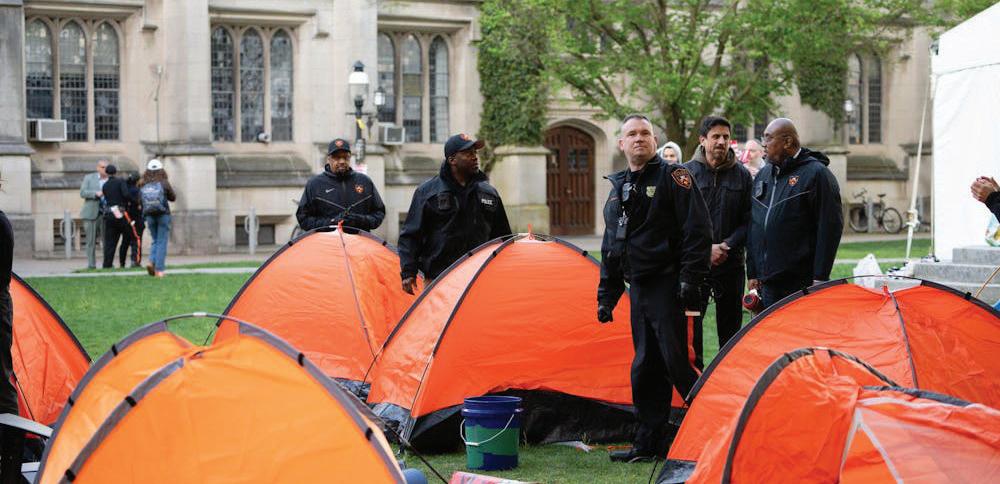
By Bridget O’Neill & Laila HartmanSigall Head News Editor & News Contributor
The Council of the Princeton University Community (CPUC) convened for its first meeting of the 2024–25 academic year on Monday, Sept. 30, centered around the proposal from Princeton Israel Apartheid Divest (PIAD) calling for the University to divest from Israel. Chair of the Resources Committee John Groves announced a “community input process,” marking the first major step from the University towards establishing a process to consider divestment.
From Sept. 30 to Oct. 11, students, faculty, staff, and alumni can access a feedback portal, which also includes PIAD’s full divestment proposal and guidelines for the Resources Committee’s consideration of investmentdriven “social responsibility” issues.
Groves explained that the Committee operates by considering three criteria. The item must “have a sustained interest on campus,” there must be a “direct contradiction with the simple value of the University,” and there must be a “strong consensus regarding what to do,” he told the CPUC.
According to Groves, the portal’s objective is to “assist the Resources Committee in its process, and then review the consensus of how the university should respond.” The portal is also intended as a solution to the Committee having received “literally thousands of emails,” many of which were identical, he said.
“We hope to get input from a broad cross-section of the University,” Groves explained. “We have the feeling that we have heard from, let’s
say, most interested parties. Maybe we haven’t heard enough from everybody.”
The meeting’s agenda also included introducing the committees of the Council, followed by a question and answer section; an introduction of the new Dean of the College, Michael Gordin; an update from the Resources Committee; a presentation on protest and free expression policies; and concluded with a presentation about Title VI and community responsibility.
In the meeting, a group of about 20 protesters, several of whom are facing municipal court charges for participating in protests last spring, held up signs that read, “Princeton your hands are red,” and “Drop the charges.”
Following Groves’ presentation, several CPUC members raised questions about the divestment process.
U-Councilor Anuj Krishnan ’27 asked what to expect after the public consultation period, and asked “What is the end product?” According to Groves, the Committee will “issue a report at some point,” but the timeline is uncertain.
U-Councilor Chloe Long ’26 asked about what consensus looked like for previous divestments such as apartheid South Africa. The Resources Committee, formed in response to student protests against South Africa had not yet adopted the current guidelines that include campus consensus. Groves stated that “South Africa was a very long time ago,” and added that reviewing the Committee’s reports may be the best method to understand what past consensus assessments looked like.
Throughout the questioning period, Groves repeatedly restated the panel’s intended goal of gathering information.
Alumni Committee member Maria Carreras Kourepenos ’85 asked how alumni are being informed of the portal.
“We’ve discussed that a lot, and I think that it’s not so clear how best to do that,” he responded, adding that alumni may learn of the portal through publications such as the ‘Prince’ and Princeton Alumni Weekly (PAW).
Gadi Dechter, Vice President for Communications and Government Affairs, then shared a new website centralizing the University’s policies around protest. He stated that the University is making efforts to promote the new website, including taking out advertisements in the ‘Prince’ and in Town Topics.
The ‘Prince’ newsroom functions independently from its business operations.
“That’s unusual for us in our office, but it reflects our commitment to ensuring people are aware of their rights and also rules,” Dechter said. Other efforts include promoting the site on social media and table tenting in popular areas on campus.
Dechter shared that as of last week, the University approximated that 4,500 individuals have visited the site, with people spending the most time on the FAQ page.
At the conclusion of his presentation, protesters left the meeting while chanting, “Disclose, divest, we will not stop, we will not rest.”
Afterwards, Vice Provost for Institutional Equity and Diversity Mi-
chele Minter presented an update on Title VI, which prohibits discrimination on the basis of race, color, and national origin in programs that receive federal assistance.
Minter began by reviewing Princeton’s Policy on Discrimination and/ or Harassment, and then addressed how bias, discrimination and harassment on campus are handled. While all concerns and complaints are reviewed, she explained, only those that violate the policy on discrimination or harassment are referred for investigation.
She notably remarked that some incidents, such as graffiti, lack a clear perpetrator, and therefore several types of complaints like it do not reach the level of a discrimination or harassment policy violation.
“A lot of problematic conduct is protected speech. We have very robust speech protections on campus,” she said.
Minter then focused on a specific subcategory of harassment referred to as hostile environment harassment, which specifies that harmful conduct “does not have to be directed at a person. It has to be experienced by a person, but that person does not have to have been the person who was specifically targeted.”
“So I would like to ask for your help,” Minter said. She requested that community members report graffiti of similar items to ODUS, refer identity-based corners or complaints to bias@princeton.edu, and participate in inclusive learning environments.
Earlier this month, a graduate student discovered small flyers outside Spelman Hall reading ”Nuke Gaza“ and ”Kill Roaches,” prompting a bias
investigation from the Department of Public Safety. Minter wrote to the ‘Prince’ at the time that “Anonymous, offensive speech is especially concerning.”
During the question and answer period of the meeting, Zach Goldberg ’28 and Raquel Rodriguez ’28 asked questions on behalf of Sunrise Princeton about why the University owns PetroTiger, an oil and gas company from which the University reported $140 million of earnings in investment income and cash transactions over a 10-year period.
Vice President for Finance Jim Matteo responded that the investment, which he said began in the 1980s, is consistent with the University’s public commitments regarding disassociation and divestment from certain segments of the fossil fuel industry. He added that decisions about divestment are directed by the Board of Trustees.
In 2022, the Board voted to divest from all publicly traded fossil fuel companies as part of its “commitment to achieving a net-zero endowment portfolio over time.” Rodriguez asked what a timeline for a net-zero endowment might look like, to which Matteo responded that there was no set timeline.
The CPUC will meet next on Monday, Nov. 11 in the multipurpose room of Frist Campus Center.
Laila Hartman-Sigall is a News contributor for the ‘Prince.’ She is from New York City.
Bridget O’Neill is a head News editor for the ‘Prince’ from Palm Beach Gardens, Fla.
“When he was not there, we chose to stay inside of his office, and we asked University staff members to leave.”
By Miriam Waldvogel & Katelynn Lee Associate News Editor & News Contributor
with the Resources Committee of the Council of the Princeton University Community recently opening a feedback portal on the proposal to divest, to establish whether campus consensus exists to move forward with the proposal.
Staff told to exit by an unknown protester Ryave also spoke under oath about interactions between Graduate School staff and protesters, claiming that protesters asked them to leave after deciding to occupy the office.
Princeton Alumni Weekly (PAW) reported last spring that protesters in the office suite on the first floor of Clio Hall gave staff 60 seconds to leave the office. Anonymous staff members told PAW that protesters then began a countdown. In her testimony on Tuesday, Ryave said she did not recall any such countdown, but she confirmed that someone did ask staff members to leave.
The Department of Public Safety and University officials then considered how to remove all staff from the building, according to PAW’s report, choosing to use the back door. Staff waited to be removed from the building in the vestibule outside of the room the protesters were occupying.
At that point, additional protesters had converged around the doors outside Clio. In a May 1
statement, Professor Ruha Benjamin along with three other faculty present wrote that these protesters “opened up a corridor” for staff to exit the building, staff members recalled that the protesters outside did not initially move to allow staffers to leave.
Claims that they were not organized
Over the three weeks of the “Gaza Solidarity Encampment,” groups like Princeton Israeli Apartheid Divest (PIAD) and Students for Justice in Palestine (SJP) posted about protests, but no single group claimed unilateral responsibility for organizing the sit-in.
Ryave told McCarthy, the judge, that the group of individuals who occupied Clio Hall were not part of any organization and had no unified leadership, making them separate from these other organizations.
Since May, pro-Palestine protesters have described protest actions similarly, denoting that they were organized by an “autonomous group” while promoting the incidents through formal organization accounts. The tact was used to explain the vandalization of the SPIA building/ fountain and Nassau Hall in the spring.
Vitus Larrieu is a senior News writer and head Podcast editor for the ‘Prince.’
Isabella Dail is a staff News writer and head editor for The Prospect for the ‘Prince.’
By Ethan Cheng Contributing Constructor

The Princeton University Art Museum announced its first-ever curator of provenance, MaryKate Cleary, last week. This was part of a wider effort to expand its examination of the origins and ownership history of artifacts in its collections.
“It is really a thrill,” Cleary said at an event on “Provenance and the Modern Museum” last Wednesday, in which she discussed the art museum’s past provenance work and upcoming efforts with Museum Director James Steward and curators Carolyn Laferrière and Perrin Lathrop GS ’21.
Cleary, previously based in the United Kingdom, has worked with the Metropolitan Museum of Art and the Museum of Modern Art in New York City. She specializes in issues of Nazi-era dispossession, including maintaining an online database of over 70,000 objects stolen or lost during the period.
During the event, Steward expressed a desire to reevaluate how museums think of the artifacts in their collections.
“We must move past thinking about ownership and think instead of stewardship, about being the custodians pro tem of works,” he said. “We’ll join all of our curators in conducting provenance research, alongside our commitment to publish openly and over time, the provenance of all 115,000 objects presently in our care.”
Currently, the museum has published provenance research of about 22,000 objects, according to Art Museum spokesperson Morgan Gengo.
However, deciding what to
do with artifacts after their origins are determined may not always be straightforward, as demonstrated by a series of objects linked to alleged art smuggler Edoardo Almagià ’73. Sixteen artifacts linked to him remain in the museum’s collections, months after the museum’s provenance research established connections between the artifacts and the long-investigated alum.
Over the summer, the museum transferred two objects indirectly purchased from Almagià out of its collections, according to Gengo, speaking on behalf of the museum. However, not all its efforts to remove Almagià-linked artifacts have been successful.
“There remain in the possession of the Art Museum an additional four objects on loan from Mr. Almagià which we have repeatedly attempted to return, but about which we have yet to receive a response from Mr. Almagià,” Gengo wrote.
Almagià did not return two phone calls seeking comment.
Last April, the Manhattan District Attorney seized six pieces of art connected to him from Princeton’s art museum, alleging that they were stolen before being acquired by the University.
At the event on Wednesday, two curators offered examples of how provenance work can inform the art museum’s practices.
Laferrière, associate curator for Ancient Mediterranean Art, recalled the story of a marble goat head statue. In 1952, a 1,800-year-old marble head of a goat under the museum’s Mediterranean Art collection was discovered to have been stolen. It rightfully belongs to a museum in Rome.
“Knowing that this particular object was such a favorite
by students here, who would call it a little icon, the Italian government actually decided to give it back to the [University] museum back in [1953],” Laferrière said. “That’s how we’ve come to have it here.”
Lathrop, the assistant curator of African art at the art museum, referenced a collection of 150 artworks from the Democratic Republic of Congo donated to the museum by Joyce Doyle, the spouse of Donald B. Doyle Class of 1905. She said Joyce Doyle’s correspondence helped the art museum understand that “her collecting really was tied to the activities of the mine for which her husband worked.”
“Our goal is to eventually create an interactive display and website that brings this collecting history to life, but also helps us raise critical issues about Doyle’s presence in Congo in the 20th century,” Lathrop said.
While not nearly as numerous as Doyle’s collection, the art museum’s 16 Almagiàlinked objects may not be the last provenance question the museum has to consider.
“Given the scope of the Museum’s holdings, similar questions may arise in the future, whether involving other objects with ties to Almagià or other works,” Gengo wrote to the ‘Prince’ on behalf of the museum. “The merits of such questions will be evaluated on a case-by-case basis, following the Museum’s established commitment to both lawful and ethical custodianship of works of art.”
Miriam Waldvogel is an associate News editor and the investigations editor for the ‘Prince.’ She is from Stockton, Calif. and often covers campus activism and University accountability.
Katelynn Lee is a News contributor for the ‘Prince.’


By Bridget O’Neill Head News Editor
President Christopher Eisgruber ’83 shared in an interview with The Daily Princetonian that the University will not consider institutional neutrality. The University administration will maintain the current policy of institutional restraint although Eisgruber expressed plans to issue statements “less frequently.”
Under institutional neutrality, universities do not take positions on social and political issues. Peer institutions such as the University of Pennsylvania, Harvard University, and Cornell University have recently released statements pledging commitments to furthering institutional neutrality following highly polarizing Pro-Palestine protests in the spring semester.
“No.” Eisgruber responded when asked if the University is considering implementing institutional neutrality.
“You can’t be neutral about everything,” Eisgruber continued. He specifically noted speaking on behalf of diversity, inclusivity, free speech, academic freedom, and sustainability. “We got to do it … We’re speaking out on behalf of those things. So I think institutional neutrality is just a misleading formulation.”
This selective approach to issuing statements is called institutional restraint, the principle that universities are not neutral but instead value-laden institutions that can take positions in
rare cases concerning the core values of the University.
“We have to stand up for our values … I’ve spoken, and will continue to speak boldly for those values, where that’s required, for the institution, and at times beyond the way in which other university presidents are doing that,” Eisgruber said in defense of maintaining institutional restraint.
Still, on certain topics, Eisgruber believes he has an “institutional responsibility” not to speak out.
“Something I share with the people who embrace the idea of institutional neutrality [is that] the University is first and foremost, not itself the critic. It’s the sponsor of critics,” Eisgruber said.
He specifically referenced the Dobbs v. Jackson decision reversing Roe v. Wade as a moment when he felt he should not speak out, despite his expertise in law and other university presidents doing so.
Despite holding back on certain issues, Eisgruber has issued statements on current events to recognize their “momentous character” and “the way in which they are affecting people on campus.” Recent examples include statements on the War in Ukraine and a condemnation of the Oct. 7 attacks by Hamas. In these statements, Eisgruber shared that he makes sure to use the first person.
The University has also taken actions which would be considered violations of institutional neutrality, most notably
divestments from South Africa and companies in Sudan and partial divestment from the fossil fuels sector during Eisgruber’s presidency. Eisgruber pointed out that the University of Chicago, which created and follows the Kalven Report, a guideline to institutional neutrality, never divested from South Africa.
In a speech during first-year orientation, Eisgruber indicated a desire to practice even further restraint. “I have rarely made statements in the past and plan to do so even less frequently in the future,” he said to the crowd.
When asked how he came to this decision, Eisgruber said determining which issues to comment on is difficult. “If we comment on those kinds of things that are in the news, we’re constantly doing this calibration. Do I comment on this event or on that event? How do we get it right?” he said.
He further believes that living in a “highly polarized world” lends itself to recognizing the pragmatic reasons to abstain from certain statements.
Instead, in line with the philosophy of the University being the “sponsor of critics,” Eisgruber said, “There’s more reason just to leave the comments about current events, in particular to our faculty and our students.”
“I have spoken out more, in retrospect, than I would say makes sense for the future,” Eisgruber said in the interview.
Eisgruber shared that this further restraint will take shape in reduced email messages and blog posts in response to current events, although he will continue to “look for ways to speak through what are, in some sense, traditional, long form presidential ways of speaking to issues.”
Eisgruber’s direct rejection of consideration of institutional neutrality differs from peer institutions such as Yale University, which recently set up a committee to consider the policy.
The debate around institutional neutrality is not new. In 2021, following urges from professors, especially conservatives and free speech advocates, to adopt the policy, Eisgruber tasked a subcommittee within the Faculty Advisory Committee on Policy with considering statement-making by units of the University. The committee’s policy recommendation
aligned with institutional restraint.
Eisgruber noted that due to the ease of distributing statements digitally, there is sometimes an expectation for statements from him, an expectation he must navigate. For example, in Spring 2022, hundreds of students signed an open letter urging the University to take a public stance on the War in Ukraine, including students from the region.
The University will keep navigating these pressures while maintaining its historic ability to issue statements when its values are challenged.
“Princeton has a broader history which is important to us, where we have recognized that in rare sets of circumstances, the University actually takes positions,” Eisgruber said.
Bridget O’Neill is a head News editor for the ‘Prince’ from Palm Beach Gardens, Fla.
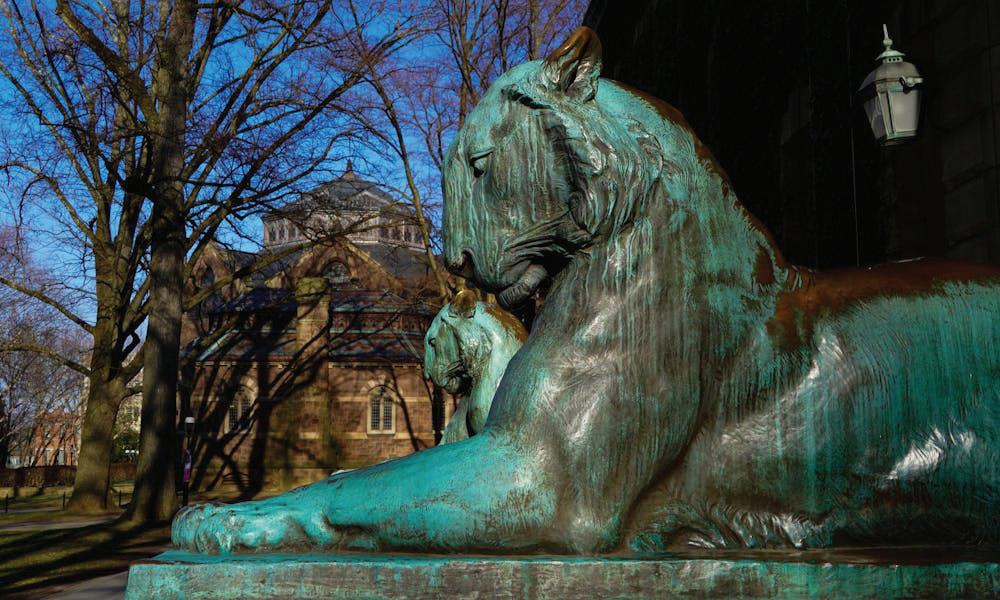
By
Students and faculty in the Program in Latino Studies (LAO) at the Effron Center for the Study of America are beginning prospective discussions on changing the gendered language used in the program’s name. While no formal recommendation has been made, both students and professors have emphasized a need to engage in conversations around the usage of “Latino.”
“At the Effron Center, it is crucial that we model scholarly and meaningful conversations that produce transformative change, both on campus and in the wider world,” Professor Aisha Beliso-De Jesús, the Olden Street Professor of American Studies and chair of the Effron Center, wrote in an email to The Daily Princetonian.
“When the question was raised about the continued relevance of the term ‘Latino,’ we saw an opportunity to begin a serious dialogue.”
The potential new terminology surrounding LAO aims to “reflect gender inclusivity” while also acknowledging “the specificity of the Latin experience in the U.S.,” according to Professor Yarimar Bonilla, who teaches American Studies in the Effron Center.
“One of the reasons we are reconsidering the term ‘Latino’ is because it has been critiqued for normalizing cis-masculine gen-
ders as the default, without allowing for the fluidity of cis or trans women, or other non-binary identities,” Beliso-De Jesús wrote to the ‘Prince.’
Students raised the same primary concern.
“‘Latino’ is kind of problematic because it’s homogenizing an entire population,” Destiny Gonzales ’25, who is minoring in Latino Studies, said.
The “o” suffix in Spanish designates the term as masculine, reinforcing a traditional gender binary that “erases those who identify as women, non-binary, or queer,” according to Effron Center Professor Lorgia García Peña.
“This is why terms like ‘Latinx’ and ‘Latiné’ have become increasingly used; they are more inclusive of the diversity of gender and sexuality within these communities,” Beliso-De Jesús wrote.
Commonly used labels such as “Latino” and “Latinx” also hold various meanings for different individuals, adding another layer of complexity to the conversation.
While García Peña uses the term “Latinx” in her writing and teaching, she also acknowledges that other people have different preferences for word choice.
“They prefer ‘Latiné,’ which to me reinforces Spanish linguistic dominance, which is not how I view Latinidad. So, the terms are complicated and the debates are rich,” she said.
Bonilla also acknowledged the complexity of ‘Latinx’ as an alternative.
“For some people, [‘Latinx’] reflects a gender-neutral term, but for other folks, it reflects a specificity of second-generation Latino/Latinas born in the U.S.,” Bonilla said.
Faculty and students also want to take into account the close geographic connection between Latin America and the Caribbean as they reconsider the terminology used in the program and at the Center more broadly.
“I feel like there’s kind of a divide in whether you’re talking about the Caribbean or other Latin countries,” said Valeria Velasquez ’27, who is considering a minor in Latino Studies.
“We share a lot of the same cultural values and traditions, but the whole ‘Latino’ category is just too broad of a category — it encompasses so many different people from different places, so it’s really hard to group them all together into this one term,” she said.
“Latino Studies and Caribbean Studies have been integrally connected,” Bonilla said. “We wish to find a name and a definition and a purpose for what we want to do here that speaks to our strengths and to the directions in which we want to go.”
Currently, the Effron Center is coordinating workshops and discussions to explore the different terms being considered, includ-
ing their histories, evolutions, and contemporary applications. The first of these workshops is scheduled for November 19th, and will feature Professor Jonathan Rosa from Stanford University’s Center for Comparative Studies in Race & Ethnicity.
“My sense is that the debate is what’s much more important than the label that we use,” Rosa said. “On the one hand, you’re seeking to institutionalize something and you want it to be widely legible; on the other hand, you want to be responsive to community needs and concerns.”
Students and faculty emphasized the importance of discussion and Princeton’s strengths in facilitating such discussions.
“It’s actually a rare occasion to have a moment to pause and reflect and really think through what you want to do, and to document that reflection as well,” Bonilla said. “This is a time for us to think through what will make Latino, Latinx, Latina Studies — whatever the name ends up being — distinct in the field and across the nation as emerging as a new center.”
Rosa highlighted the vitality of the Effron Center’s faculty in particular. “At a place like Stanford, we don’t hire people often in Latino Studies; we hire people in mainstream disciplines like sociology or anthropology,” he said. “Princeton is recruiting scholars in Latino studies and strengthening their Latinx,
Latine, Latino studies tremendously, and that’s very exciting.”
“I’ve been really happy with the faculty that they’ve hired,” Gonzales said. “I feel like the curriculum has been really radical and I really like that.”
In addition to conversations surrounding the way that terms such as “Latino” are used at the Center, certain aspects of the curriculum will also be reviewed, according to García Peña. “We will necessarily look at the name, at the curriculum, programming, and more to make sure the program reflects the scholarship, rigor, and commitments of our faculty and students,” she said.
As the Effron Center continues to expand and incorporate new faculty appointments, Beliso-De Jesús noted that one of its broader aims includes engaging deeply with how the LAO program “addresses and includes the experiences of Latina/o/x/é people in the United States from Mexico, Latin America, the Caribbean” and explores the “transnational and diasporic negotiations with and between imperial, colonial, and capitalist projects.”
García Peña said, “It is a really exciting moment for Latino/a/x/é Studies as the field is growing globally, and I am excited to see how this growth manifests at Princeton.”
Sena Chang is a News contributor for the ‘Prince.’
By Eojin Park & Sena Chang
Contributing News Writers
As part of a new pilot program, all graduate students not on a meal plan had 12 free meals automatically loaded onto their PUIDs for use over the course of the fall semester. The program, called the 12 Free Meals Pilot Program, kicked off on Sunday, Aug. 25 and gives students access to meals in Procter Hall, the dining hall located in the Graduate College. The program doubled the number of free meals that graduate students receive per semester.
The program is being piloted in collaboration with the Graduate School, Dining Services, and the Office of the Vice President for Campus Life, following a year-long effort by the Graduate Student Government (GSG) to increase the number of free meals for students.
“The reason that I identified this as a problem initially in the summer of 2023 was because I became aware of the Upperclass Two Meals Per Week program,” Christopher Catalano GS, GSG vice president, told The Daily Princetonian.
The Two Meals Per Week program provides undergraduate juniors and seniors with two meals per week in any dining hall, regardless of whether they have purchased a meal plan. “We saw that and immediately noticed the disparity between how the undergrads and the graduate students are being treated,” Catalano said.
Dissatisfaction with the graduate student dining system was not a concern solely highlighted by Catalano.
In a survey conducted by the GSG in March 2024, over 99 percent of respondents expressed that the implementa-
tion of a “Two Extra Meals” pilot would “positively” or “very positively” impact students’ sense of community on campus. Free-written responses from graduate students included, “I would love this so much. I would feel so much more connection to the University,” and “This would literally be the best benefit we’ve ever gotten as a grad community.”
“Many graduate students work 10 to 12 hours per day with little access to free or affordable food,” Amari Tankard GS, the GSG president, told the ‘Prince.’ Meanwhile, she said, “The undergrads have access to not just a plethora of dining halls, but also guest swipes that graduate students are barred from.”
“I’m a grad student — I’m busy,” Catalano added. “I don’t have time to get groceries, and I don’t want to pay for takeout on Nassau Street again and again, because it really is adding up in my budget.”
Although graduate students are presented with the option to purchase a dining plan, the plan is unaffordable for many. “The $3,000+ dining plan is well outside of our budgets,” Tankard said.
In April 2024, Catalano led the effort to draft a policy proposal to add free meals alongside several members of the executive board. The GSG Executive Committee initially proposed two free meals per week at any dining hall — on par with the corresponding program for undergraduate juniors and seniors. However, the number of free meal swipes in the proposal was eventually reduced, as the Executive Committee and the administration reached a compromise with the 12 free meals pilot. In December 2023, Catalano ran for GSG vice president on a platform that em-
phasized achieving parity for graduate students.
“This policy change is the result of six months worth of effort, including a formal proposal and several meetings with the Graduate Housing Advisory Board (GHAB) and the Graduate School,” Tankard said.
The new pilot is part of a broader effort by the GSG to “make grad students feel like an equal partner on campus,” according to GSG Facilities Chair Alana Bernys GS. “Over the last couple of years, GSG has been focusing on how we can include graduate students in the community-oriented focus of the University.”
“The Graduate School is delighted to have worked with Campus Dining and the Graduate Student Government (GSG) to shape a pilot program that doubles the free meals available at Procter Hall,”
Tracy W. Meyer, the director for communications at the Graduate College, told the ‘Prince.’
In their policy proposal, GSG used Wintersession as a case study demonstrating “the positive impact that complimentary meals can have on fostering a sense of belonging and camaraderie.”
Bernys said that Wintersession is often “the best two weeks of the year for many grad students” because of its strong “sense of community” and unlimited food. She expressed a desire to cultivate a similar atmosphere for graduate students year-round. “It’s really about sitting over a meal with some friends and exchanging ideas — just talking, letting off steam.”
“It’s great for mental health as well,” she added.
The continuation of the pilot is con-

tingent on its continued success and impact. “After the fall pilot, the Graduate School will work with Campus Dining and the GSG to evaluate the program’s usage and impact,” Meyer noted.
In the future, GSG aims to broaden its reach in the dining halls and allow graduate students greater access to free meals.
“Let’s expand this pilot program to two meals a week, or one meal a week,” Catalano said. “We’re limited to Procter Hall whereas undergrads can use their meals anywhere; people are really hoping that we can get access to the dining halls on campus too.”
Procter Hall is a 20 minute walk from the main campus.
Student leaders like Tankard have also proposed initiatives like Too Good to Go Princeton, a project that would reduce food waste while reducing the financial burden on graduate students.
“At Columbia, my undergraduate insti-
tution, we were allowed to take any and all dining hall food [left over] at the close to prevent it from going into the trash,” Tankard told the ‘Prince.’ “I wish that Princeton could find a liability-free way to give [leftover food in dining halls] to the students who want and need it.”
According to Catalano, student reactions to the pilot program have already been overwhelmingly positive. He reported that GSG has received over 100 emails of appreciation in the days following the announcement.
“So far, we’ve already heard that the brunches at Procter have been absolutely huge, in terms of more people being there and it being this really lively community environment,” Bernys added.
Eojin Park is a contributing News writer for the ‘Prince.’
Sena Chang is a contributing News writer for the ‘Prince.’
By Hannah Gabelnick & Devon Rudolph Staff News Writer & News
President Mohamed Muizzu of the Maldives joined the Princeton School of Public and International Affairs (SPIA) on Sept. 26 for a discussion on climate resiliency in the Maldives. While the event was marketed as focusing on the Maldives’ urban development and environmental initiatives, the conversation, moderated by visiting professor and lecturer Razia Iqbal, soon pivoted to the Maldives’ June 2024 entry ban for Israeli passport holders.
A part of the Dean’s Leadership Series, the event is one in a sequence of discussions featuring global leaders and policymakers. Muizzu began by thanking Princeton for hosting him.
“Princeton University and its School of Public and International Affairs are a beacon of the principles of the governments and society and money around the world, principles of equity, justice and respect for basic human rights,” he said.
“In these dark days of war, genocide in Gaza, the suppression of human rights, the normalization of violence against Syrians — even children — it is vital [that] U.S. institutions continue to uphold these principles themselves,” he continued. “Universities must remain vesicles of thought and expression, respecting the right to protest peacefully, responsibly, and in a manner that is constructive for society.”
He then turned to the climate crisis facing the Maldives — in particular, rising sea levels. The country’s
average elevation above sea level is only around one meter, so rising sea levels threaten displacement. Another issue is the acidification of coral reefs, which endangers tourism and fishing.
“We’ve stepped up and increased our ambitions,” Muizzu said regarding climate mitigation. “To generate 33 percent of our electricity through renewable energy by 2050, we are experimenting with floating solar panels.”
Iqbal raised questions about the source of funding for these projects. Historically, the Maldives has maintained close international ties with India, but this relationship has come under pressure amid global power competition. In recent months, Muizzu has made multiple agreements with the Chinese government for infrastructure funding and other investments.
In response to a question from Iqbal about this shift, Muizzu replied that the issue “has been very diplomatically coordinated, and with the full support of [the] Indian government.”
“I’m going to ask the question again, because I’m not convinced you answered it,” Iqbal said. “Is China part of your plan to build climate resilience inside the Maldives?”
Muizzu confirmed that China would be an integral part of the developmental projects inside of the Maldives.
Iqbal then turned to Muizzu’s recent criticism of Israel, asking if he believes his criticism makes a difference.
“We are all humans — equal — and everyone has the right to live,” he responded. “Everyone has the right to belong to an independent state.”
When asked by an attendee about the Maldives’ criticized anti-LGBTQ+ policies, Muizzu replied, “This is an Islamic country. We have Islamic rules from all these constitutions.”
The conversation then opened to the audience for questions. Dean of SPIA Amaney Jamal asked about the Maldives’ decision to ban Israeli passport holders from entering the country in protest over the war in Gaza.
“We have many students who also have family and friends in Israel, and I know that the Maldives had imposed a ban on Israel, but then walked that back. But what would you tell our students who still are worried and anxious about this decision?” she asked.
“No, we haven’t walked back from all of this in the parliament,” Muizzu replied. “We just want the world to acknowledge that every single Palestinian has the right just as everyone else [sic].”
“We are ready to do anything we can and we decided to put in this plan, and it’s going to be implemented as soon as possible,” he added.
The Maldives recently attempted to adjust its Israeli passport ban to allow Palestinian and Muslim Israelis to enter the Maldives. Maximillian Meyer ’27 asked Muizzu about this decision, stating, “The message [of the legislation], of course, was clear: only Jewish Israelis are not welcome in the Maldives. Despite, as you said today, your desire to create an ‘inclusive society,’ how can you justify your government’s actions as anything other than antisemitic?”
Meyer, who is president of Tigers for Israel, co-authored a letter with Tigers for Israel Vice President Aid-
en Sandler ’27 addressed to University President Christopher Eisgruber ’83 and Jamal. In the letter, they express their “utter dismay” that SPIA was hosting Muizzu.
“Irrespective of one’s perspective on the Israel-Hamas war, President Muizzu represents precisely the antisemitism against which Princeton ought to stand strongly,” they wrote.
“I think you are taking it to the wrong angle … the ban that we have been discussing within the parliament is … a genuine attempt to say that violence taking place in Palestine is not right,” Muizzu replied to Meyer. “It’s nothing against Jews or any religion. Everyone is welcome. Jews, Christians, Muslims. Everyone is welcome in the Maldives. It’s nothing to do with religion. It’s right and wrong,” he added.
Another attendee, Oliver Meyer ’28, told The Daily Princetonian in an interview that Muizzu’s policies regarding Israeli passport holders
motivated him to attend the event.
“I came to the event today because the school invited somebody who is incredibly antisemitic to speak here, and if we’re going to prop him up, I think it’s our duty to see what he has to say, and see if he can explain himself for some of the things that a lot of the Jewish students feel are incredibly dangerous.”
Iqbal and a representative for Jamal declined to comment to the ‘Prince.’ SPIA Events Manager Lauren Mosko did not respond to repeated requests for comment.
The Dean’s Leadership Series continues Friday, Sept. 27 with His Excellency President Santiago Peña of Paraguay.
Hannah Gabelnick is a staff News writer for the ‘Prince’ from Buffalo, N.Y.
Devon Rudolph is a News contributor and a Sports contributor for the ‘Prince’ from Fairfax, Va.

By Luke K. Schreiber Contributing Constructor
1 Design made in the snow
6 Henry Olusegun Olumide Adeola Samuel, to fans 10 Recedes 14 King of TV interviews
Really liking 16 Darth Vader's daughter
Vetoed
19 Part of the eye
20 "What's up"
21 It's "just a number"
22 Happenings, with "on" 24 Charity
26 This clue's answer is obvious
29 "Duck-and-cover" exercises
34 "Unhand me!"
36 Email classification
37 Place at the table
38 Gibson who was the first African American to win a Grand Slam
40 Pepperoni, e.g.
42 "Yeah, sure"
43 Pink, as for a hamburger
47 System that often uses waves and dishes
48 Predecessor to cake often topped with cream cheese frosting
51 Bun holder, perhaps
52 Fine powder
55 Forest gods
58 "I didn't need to know that," in text
60 Stock launch, for short
61 Final or midterm
62 Droid played by Kenny Baker ... or a hint to this puzzle's theme?
66 There are 6.02214076×10²³ particles in one
67 Approach
68 The painting "Movement in Squares," for example
69 Contents of printer cartridges
70 Alvin, Simon, and Theodore, to Vinny and Dave 71 Ground-dwelling songbirds
1 Hawaiian hello 2 Umbilical cord attachment site 3 Some nervous tissue 4 Make a mistake 5 Instrumental constellation 6 Site of jury-less discussion 7 Minecraft dimension with a dragon, with "the" 8 Slayed

9 Slim to none chance 10 Immigration hub close to the Statue of Liberty 11 "You've ___ served!" 12 Microsoft search engine 13 Cheek 18 Tyler, the Creator's first number-one album 23 "___ little secret" 25 Bear and dear, but not beer and deer 27 Try (for)
28 ___ B. Wells 30 Some eggs 31 Hendrix solo part, often 32 Dalai ___
33 Mix, as one's coffee 34 Secular
35 Actor Idris
39 Smiths and others
41 Pop star Grande, to fans
44 Take Your Child to Work Day mo.
45 Groove
46 To whom one might say, "Mark my words"
49 Rower's instrument
50 Floor model
53 Utensil portmanteau
54 Trumpet sounds
55 Tractor-trailer
56 Dendrite counterpart
57 Chat
59 The golden calf, for one
63 Old motor inits.
64 Go for the bronze?
65 Clean air and water org.

By Madison Anderson Cartoonist
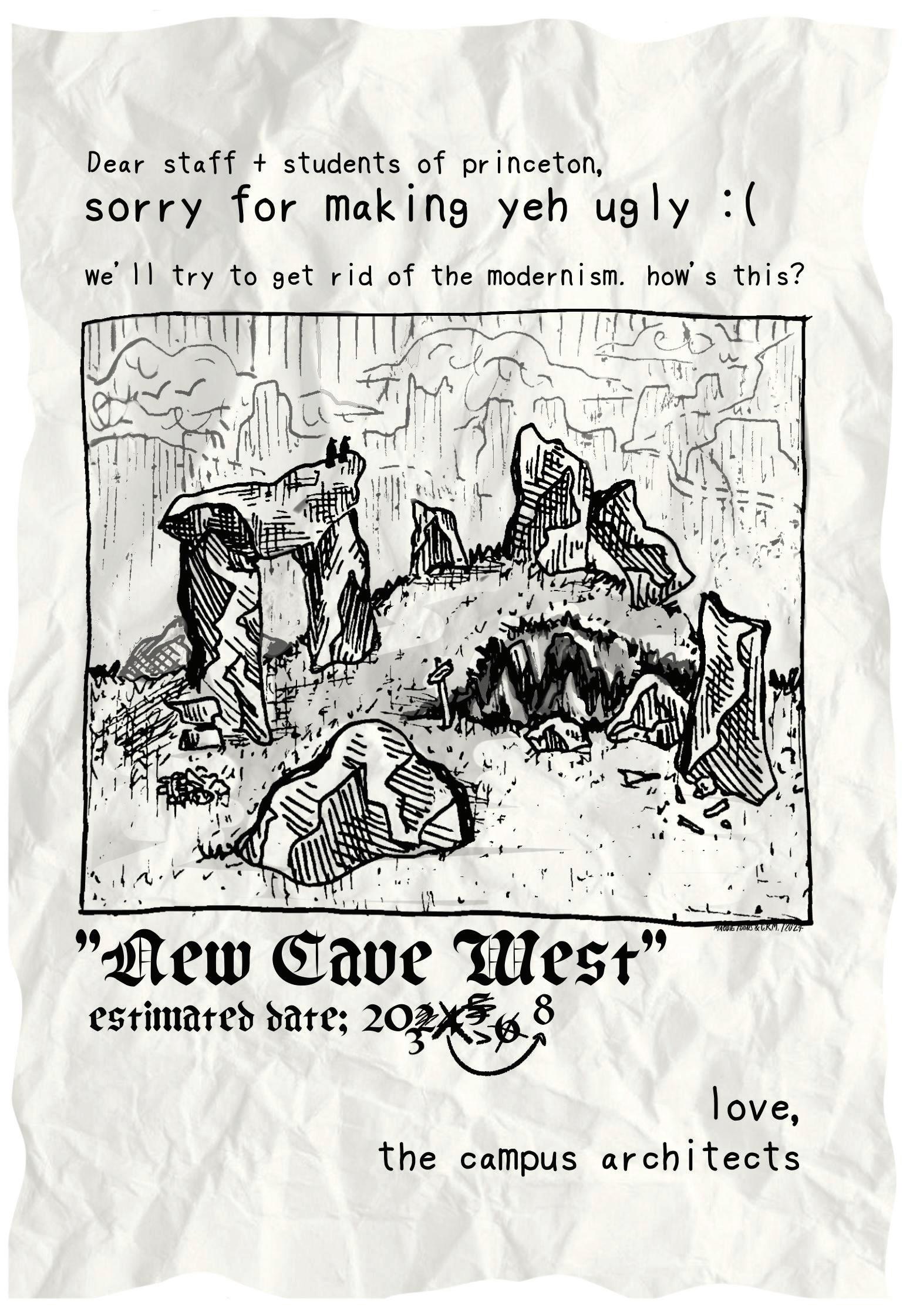
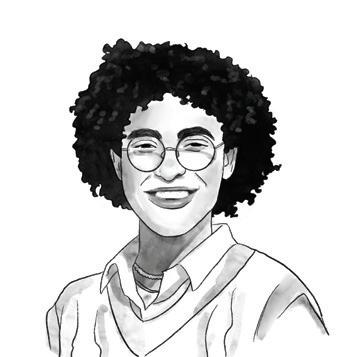
Asa Santos Columnist
If I were to buy a round-trip ticket home for winter break today from Newark to London, the cheapest ticket would cost $940. By contrast, if I were to opt for the most convenient ticket and a direct flight, it would cost me $1,166 on United Airlines. Depending on the time of booking, the time of flight, and the demand for a specific flight, these prices can frequently be higher during the holiday season. These prices don’t take into account the added fee required for checking a bag each way, which varies by airline, and they also don’t include any form of travel insurance if the flight were to be canceled. Meanwhile, my travel stipend, which is supposed to cover two round trips home, comes out to less than $1,000 per semester.
For students on full financial aid at Princeton, our stipends are individually
adjusted to incorporate a travel allowance, which is supposed to cover two round trips home. In this regard, I’m actually one of the luckier ones: my trip home, to London, is one of the cheaper international flights out of New York City. For some students, this amount is not enough to even cover a single round trip.
Princeton estimates that the cost of traveling to Princeton can range between $300 and $5,000. In an article published last January, undergraduates reported extensive travel costs, ranging from $2,200 — a round trip to Nepal — to well over $2,000 — a one-way ticket to Singapore — and $1,600 to $2,600 — a one-way ticket to Sydney, Australia — with at least one student explicitly noting that this was more than her travel stipend.
Naturally, there are many variables that factor into the University’s calculations for travel allowance and stipends, but the funds for low-income international students consistently fail to account for the full scope of the students’ travel needs. Moving forward, Princeton should work to conduct more thorough and comprehensive evaluations of student financial needs.
Beyond the bare essentials, the University’s travel stipend should strive to cover the full cost of two round-trip flights to a student’s home airport, and ideally, pro-
vide students with enough money to cover all costs related to travel — including food and extra transportation costs like train tickets or taxis. For many students, the journey home is not as simple as merely flying into an airport. Students who live in rural areas or students who cannot easily be picked up after their flight lands will require additional transport to get to and from the airport. Special focus and funds should be allocated to students from countries where it’s more expensive to travel and who may not be receiving enough money to cover even a single round-trip home.
As a low-income international student myself, I travel home at least twice a year. I consistently fly on the most basic economy ticket without a baggage allowance, often without a meal, and usually with at least one layover. However, I know other low-income international students who haven’t traveled home in over a year because their financial aid doesn’t cover the cost of their travel. Furthermore, there are some low-income international students who never travel home, due both to the inadequate travel allowance and to the high tax bill that we are expected to pay on top of it. We deserve better.
The way Princeton’s academic semester works, it’s often not possible to book the ideal, cheapest ticket. While it’s unclear
how exactly travel stipends are calculated, the University should avoid conservative estimates, and should take into account the reality that many students will be booking tickets at times when the most convenient trips may no longer be within budget. Although final exam schedules were released earlier this semester than in previous years, they are still not issued with enough notice for students to book the cheapest possible ticket. The cheapest time to book international flights is between four and 10 months before travel, or between the months of February and August for a December flight. Accordingly, it’s unrealistic to give students financial aid that would cover two round trips home at the time when the award is calculated — instead, the University should give students more than enough money to cover multiple round trips throughout the year.
As one student suggested last winter, a solution could be to subsidize flights on a case-by-case basis. The administration could also offer students an amount that surpasses their calculated cost and then adjust in accordance to take back any money that went unspent. Alternatively, Princeton could have students buy flights and then submit for reimbursement requests after they have their receipts — even if this entails booking appointments with ODUS, as student groups must do,
to use a credit card that belongs to the institution to pay for tickets that students aren’t able to front.
Princeton’s insufficient coverage of travel costs further compounds other expenses that low-income international students are already burdened with, including the tax burden on aid — which Yale covers, but Princeton does not — and uncovered technology costs. Committing to covering flights and travel entirely for international students could relieve the financial burden of having to earn enough money to support enrollment at Princeton and seeing one’s family. Some of us already work multiple jobs, and the maximum number of hours allowed under the F-1 student visa that most international students at Princeton hold is 20 hours a week. After our acceptance and enrollment, we were guaranteed four years of generous financial support and aid. Accordingly, we should be able to demand more from the University as it falls short. Princeton should commit to covering flights for low-income international students.
Asa Santos is a senior Anthropology major from London and São Paulo, minoring in Gender & Sexuality Studies and Global Health & Health Policy. Santos’ column, “Opening the Gates,” runs every two weeks on Mondays.
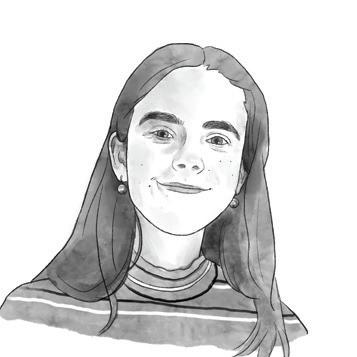
Wynne Conger Columnist & Associate Opinion Editor
Four years ago, youth voter turnout reached a record high across the nation during the presidential election. At the time, scholars lauded the phenomenon as a “tidal wave” of civic engagement and a major turning point for the youth demographic more generally. Now, election season is upon us yet again, and nearly 8 million new voters have come of age. Given the ever-changing landscape of our electorate, along with the recent surge in campus activism, it comes as no surprise that universities are once more thrust into the crosshairs of our national discourse.
As November approaches, headlines have increasingly concentrated on the major role that college students will play in the upcoming election, with as many as 700 institutions — Princeton included — committing to an “All In” Campus Democracy Challenge to elevate student voices. But as the election begins to loom in the distance, I wonder if all young electors are prepared to cast their ballot. With the election looming in the distance, we ought to pay careful attention to how political discourse on campus, or lack thereof, will shape the voter turnout in November.
Despite past statistics, concerns about student voter turnout for the 2024 Presidential election persist. A decline in the 2022 gubernatorial elections, where the youth vote polled as low as 23 percent across the nation (and only reached 20.6 percent in New Jersey) appears to suggest that the 2020 surge in youth participation may represent an irregular deviation, as
opposed to the beginning of a new trend. Although Princeton’s 2020 turnout ranged well above the national average at a rate of 75 percent, many young voters at the time benefited from pandemic-related leniencies and COVID-19-era absentee ballot policies that worked to enhance the turnout across the nation. This further deviates with historical trends of Princeton voters, whose turnout has traditionally ranged lower, around 50.5 percent in the 2016 election and 10.5 percent in 2014. Although many voters aged 18–34 indicate a strong likelihood of voting in the upcoming general election, many feel disheartened by the lack of outreach from their local or state political campaigns and community organizations. This issue is made especially pertinent in regards to the lacking dialogue on campus.
Often, lacking participation in an election tends to be attributed to voter apathy and disillusionment among the populace. This correlation is particularly prominent in relation to younger voters. Although several broader factors may act to dissuade student voters, such as an insufficient electoral education or a lack of accessible polling places, new studies indicate that pluralistic ignorance may also play a role in low voter turnout.
As a term in social psychology, pluralistic ignorance refers to a cognitive bias where an individual is led to believe that their thoughts, opinions, or private beliefs may drastically differ from that of the people around them. Consequently, individuals may preemptively alter or suppress themselves in favor of conforming to the perceived majority. This phenomenon of second-order conformity is particularly prominent within large group interactions, such as voting. Just as voter mobilization is often oriented along societal norms, the perceived “will of the majority” may subconsciously work to prevent voters from casting a ballot or supporting a policy, especially if it is deemed to be the “incorrect” choice in the public eye. After all, if these students feel as though their vote will not have a sig-
nificant impact within the larger majority of their peers, why would they be driven to vote at all?
College campuses across the nation are not immune to the potential effects of pluralistic ignorance. Approximately one in five of Princeton’s graduating seniors reported that they do not feel particularly comfortable in sharing their personal views within the broader circle of the student body.
This effect can become even more relevant within smaller ponds of select political and affiliate identity groups, where people might feel stifled by the perceived conventions or beliefs of their peers. Pluralistic ignorance presents obstacles across bipartisan lines and tends to have different implications for different groups as a result. For example, American conservatives tend to underestimate support for policies that they have personal qualms with, and consequently, have a false impression of the actual consensus. Even as Princeton is frequently noted to be the most conservative among the Ivy Leagues, the perception of the University as a “liberal space” may cause many conservative students to feel uncomfortable about sharing their perspectives with
their peers.
Unless we confront pluralistic ignorance first and foremost, I believe that this social phenomenon might pose a risk to election polling on campus in the months to come. Students who feel that their political positions are not well represented on campus might accordingly feel a sense of apathy towards an electoral process that they do not feel will sufficiently impact those around them.
Over the course of the past decade, the University has taken several steps to further facilitate the voting process and promote the student vote. In addition to the official establishment of “Tiger Ballot Day” in 2020, the Pace Center for Civic Engagement boasts a wide array of pedagogical resources to aid voters who might be unfamiliar with the nuances of the process. Student associations have also taken matters into their own hands. Both partisan and nonpartisan student groups have advanced canvassing efforts and prioritized direct forms of “Get The Vote Out” (GTVO) outreach. As of Sept. 17, Vote100 fellows and ODUS staff registered over 100 students in a mass effort to build student voting interest. Certainly, the Princeton community always makes a “good faith
effort” to expand access and efforts for voter registration prior to the national deadline.
However, there is more work to be done. Beyond the physical act of ballot-casting, I believe that students should examine their political opinions first and foremost. Beyond formalized outlets of SPIA panels and Whig-Clio speaker events, I challenge and urge Princeton students to overcome the sense of implicit hesitation and trepidation that comes with engaging in discourse. In the classroom, in casual discussion, and at the polling place, do not let a sense of political isolation discourage you from casting your ballot. This is all the more relevant as political polarization continues to heighten across party lines and as students may feel the need to suppress their opinions accordingly. Come November, I hope I can count on a new wave of change in our sociopolitical culture and, more importantly, I hope I can count on your vote.
Wynne Conger is a sophomore and prospective SPIA major from Bryn Mawr, Pa. She can be reached by email at wc2918@princeton.edu. Her column “Popping the Bubble” runs every three weeks on Thursday.
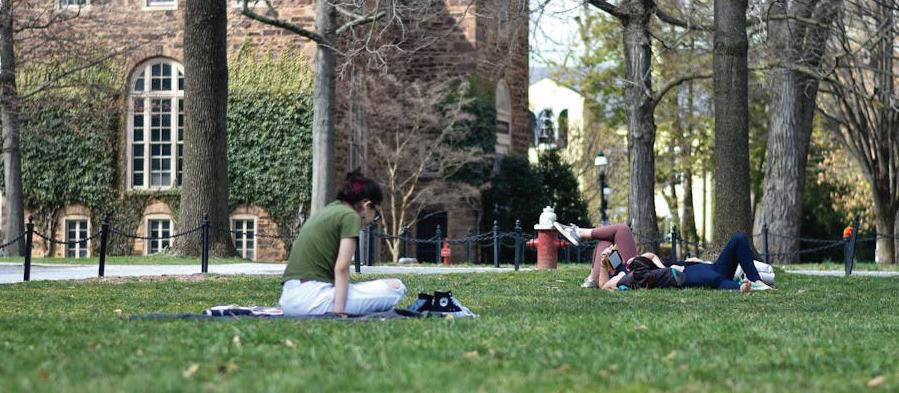
editor-in-chief
Eden Teshome ’25
president
business manager Aidan Phillips ’25
Thomas E. Weber ’89
vice president
David Baumgarten ’06
secretary Chanakya A. Sethi ’07
treasurer Douglas Widmann ’90
assistant treasurer
Kavita Saini ’09
trustees Francesca Barber
Kathleen Crown
Suzanne Dance ’96
Gabriel Debenedetti ’12
Stephen Fuzesi ’00
Zachary A. Goldfarb ’05
Michael Grabell ’03
Danielle Ivory ’05
Rick Klein ’98
James T. MacGregor ’66
Julianne Escobedo Shepherd Abigail Williams ’14
Tyler Woulfe ’07
trustees ex officio
Eden Teshome ’25 Aidan Phillips ’25
148TH MANAGING BOARD
Ryan Konarska ’25
Naisha Sylvestre ’25
director of outreach
Lia Opperman ’25
Accessibility
Christopher Bao ’27
Education
Charlie Roth ’25
Tess Weinreich ’25
Lucia Wetherill ’25
creative director Mary Ma ’26
Financial Stipend
Elaine Huang ’25
Sections listed in alphabetical order.
public editor Abigail Rabieh ’25
head archives editor
Raphaela Gold ’26
Associate Archives editor Elizabeth Clarke ’27
head audience editor Paige Walworth ’26
associate audience editors
Amparo Sanchez ’27
head copy editors Nathan Beck ’25
Bryan Zhang ’26
associate head copy editors
Lindsay Padaguan ’26 Elizabeth Polubinski ’25
head data editors Andrew Bosworth ’26
Suthi Navaratnam-Tomayko ’26
head features editors
Sejal Goud ’25 Molly Taylor ’25
associate features editor
Raphaela Gold ’26
head graphics editors
Luiza Chevres ’26
Noreen Hosny ’25
head humor editors
Spencer Bauman ’25
Sophia Varughese ’26
associate humor editors
Sam McComb ’25
Mya Koffie ’27
head news editors
Bridget O’Neill ’26
Annie Rupertus ’25
associate news editors
Olivia Sanchez ’26
Miriam Waldvogel ’26 (Investigations)
head newsletter editor Sunney Gao ’27
associate newsletter editor
Victoria Davies ’27
head opinion editor Eleanor Clemans-Cope ’26
community opinion editor Christofer Robles ’25
associate opinion editors Thomas Buckley ’26 Wynne Conger ’27
head photo editors Louisa Gheorghita ’26 Jean Shin ’26
associate photo editor Calvin Grover ’27
head podcast editor Vitus Larrieu ’26
associate podcast editors Senna Aldoubosh ’25
Theo Wells-Spackman ’25
head print design editors Avi Chesler ’25
Malia Gaviola ’26
head prospect editor Isabella Dail ’26
associate prospect editors Russell Fan ’26
Regina Roberts ’26
head puzzles editors Sabrina Effron ’26
Joah Macosko ’25
associate puzzles editors Wade Bednar ’26
Lindsay McBride ’27
head sports editors Cole Keller ’26
Diego Uribe ’26
associate sports editors Tate Hutchins ’27
Hayk Yengibaryan ’26
head web design and development
editors
Yacoub Kahkajian ’26
Vasila Mirshamsova ’26
148TH BUSINESS BOARD
assistant business manager
Jessica Funk ’26
business directors Gabriel Gullett ’25
Andrew He ’26
Tejas Iyer ’26
Jordan Manela ’26
chief technology officer Roma Bhattacharjee ’25
lead
Sanh Nguyen ’26
Anika Agarwal ’25 Carter Costic ’26 Jessica Dong ’25
Charlie Yale Contributing Opinion Writer
In 2022, 40 students graduated with a Gender and Sexuality Studies (GSS) certificate — more graduates than 27 other major programs. And yet, no one graduated as a GSS major, because the University doesn’t offer one. In fact, Princeton is the only Ivy League school that doesn’t offer some form of gender studies major. It’s time for that to change.
When University President Christopher Eisgruber ’83 spoke during this year’s Opening Exercises, he reflected on the University’s commitment to a liberal arts education, highlighting the ability to participate in all facets of public life, the merit of exploring a wide range of disciplines, and the intrinsic value of the pursuit of knowledge. One clear way to further these goals, and to meet student demand, is to create a GSS major.
Knowledge of topics covered in GSS is critical for participation in many parts of public life today. The discipline offers students a unique lens to analyze the world through by understanding gender, a factor that affects nearly every single interaction on an interpersonal and institutional level.
For example, gender studies theorists have helped to uncover and mitigate gender disparities in the drafting and enforcement of laws. Gender studies students explore how gender and sexuality have shaped civil rights, religion, education, art, literature, and popular media. Its methodology also ties into medicine and other scientific disciplines. Elinor Cleghorn, a historian, used methodology from gender studies in her popular book “Unwell Women” to write about systematic medical bias that women face around the world.
GSS is — and has long been — an incredibly intersectional discipline: Students with a gender studies background are equipped to make change in any arena. What is now gender studies started as “Women’s Studies” in the late 1960s and drew on women’s movements, the civil rights movement, and student movements of the mid-20th century to incorporate theories of feminism and interdisciplinary methodology to examine the role of women and gender minorities in society.
Detractors of gender studies, like Florida Gov. Ron DeSantis, argue that gender theory students don’t contribute to the workforce. But like the skills one learns from any liberal arts degree, the skills students learn from gender studies, including critical thinking and approaching issues with an intersectional lens, are applicable across a wide array of career paths. GSS students are, to borrow the words of DeSantis’s Commissioner of Education, “[taught] how to think, not what to think,” an approach that will be applicable far into the future.
GSS is an imperative part, even the epitome, of a liberal arts education. Gender studies students are readily able to understand gender and intersecting identities through different critical lenses, as Asa Santos ’25 explained in a column last year.
The University has offered a certificate program in Women’s Studies since 1982. In 2011, the program was renamed to Gender and Sexuality Studies to “reflect the trajectory and expanded reach” of the field since its inception. And now, it’s time for the program to make another change to mirror the advancement of the field. It’s time for the program to become a department and craft a major.
The University’s GSS program faces lots of demand. GSS has seen its annual enrollment jump from the single digits in 2011 to
40 people in 2022. There were 27 graduates who had a GSS certificate in 2024. As noted previously, more students are in the minor than some majors. Making GSS a major at the University would allow the program to grow at a faster pace and meet the rising interest that it has seen over the last decade.
Unlike the other Ivy League schools, Princeton does not permit students to double major. At Harvard, for example, approximately half of Studies of Women, Gender, and Sexuality (WGS) concentrators pursue multiple concentrations. While gender studies as a field lends itself well to a double major, the existence of sole WGS concentrators at Harvard is enough to justify a GSS major at Princeton. Princeton offers similar majors that are popular double majors at other schools, like African American Studies (AAS).
In fact, Princeton’s 2015 creation of the AAS department signified a shift in how the University crafts its majors. Much like GSS, AAS is heavily based on how intersecting identities affect the day-to-day lives of people around the world. This shift towards intersectionality in academia creates opportunities for students to understand the real world implications of policy, art, and culture. Since the program’s renaming in 2011, GSS has seen its number of students tend to increase. As demand for the minor increases, a major would offer the opportunity for students to more deeply explore a field that continually produces changemakers. Princeton must keep up with its peer universities and reaffirm its commitment to the liberal arts by offering a GSS major.
Charlie Yale is a first-year from Omaha, Neb., and can be reached at cyale@princeton.edu or @cmoyale_ on Twitter. Charlie is sorry about their last name!
Robert Mohan ’26 Kok Wei Pua ’25 My Ky Tran ’26 project managers Jason Ding ’25 Kaustuv Mukherjee ’26
148TH TECHNOLOGY BOARD THIS
Vishva Ilavelan ’27 Austin Li ’26 Allen Liu ’27
Wang ’26
Fajardo ’28 Vivi Lu ’26
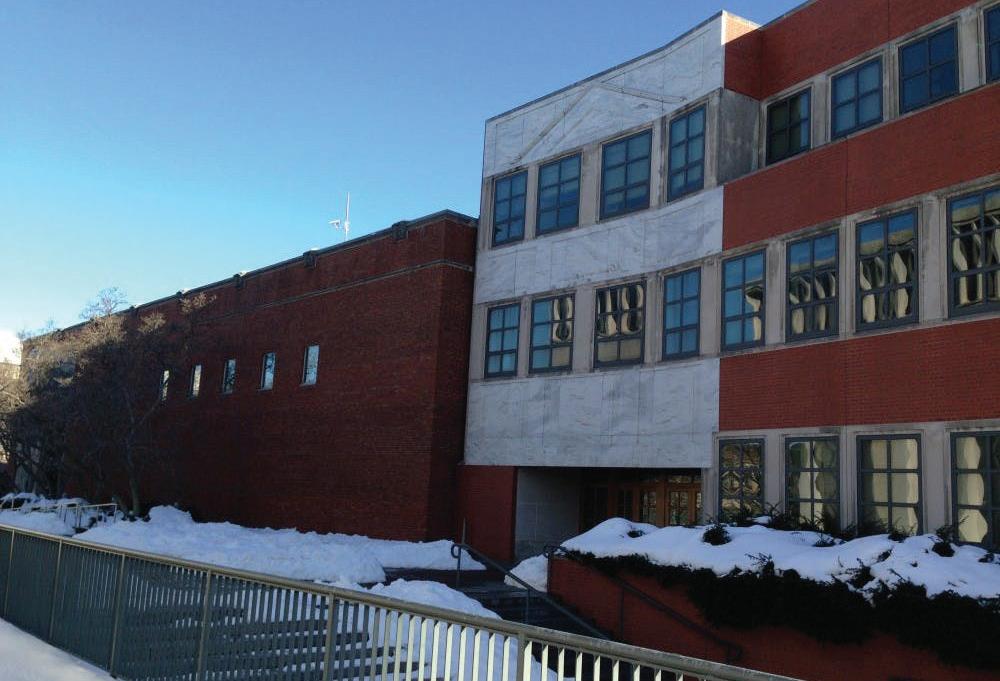
AND COPIED BY Bryan Zhang ’26
On Tuesday, the 13 University affiliates arrested at Clio Hall in April went to court for a hearing. Six of them entered plea deals to plead guilty to a municipal noise ordinance, but Princeton Municipal Court Judge John McCarthy III ’69 rejected the deals, likely sending all of the protesters to trial.
Our columnists weigh in on the fact that this case reached the courts and on the Judge’s decision.
Princeton’s choice to capitulate to prosecutor ignores criminal justice realities

By Christofer Robles Community Opinion Editor
The University has chosen to keep its distance in the case against the Clio 13, instead bestowing “full faith” in municipal prosecutor Christopher Koutsouris and, presumably, the justice system. Princeton is blithely mistaken, however, if it truly believes that any outcome from prosecuting non-violent student protest could ever be just. Besides having a disproportionate and historically ignorant response to the Clio sit-in, the University errs in unnecessarily exposing its students to the disastrous consequences of involvement with the criminal justice system. Now that the presiding judge has rejected plea deals and the case progresses, Princeton should advocate for the softest punishment possible and provide sufficient restitution to students at the conclusion of the trial.
Defiant criminal trespassing is a petty offense that can carry a penalty of 30 days in jail and a $500 fine, in addition to a criminal conviction on an accused’s permanent record. In no way do these outcomes “[maintain] student accountability,” as the University purportedly hopes. Rather, they introduce students to possibly debt-inducing fines and fees, inflict long-lasting harm to their health and well-being, and jeopardize their future economic prosperity. Further, the disproportionate effect of this all on students of color is concerning, especially when considering New Jersey’s already massive racial disparities in incarceration and enforcement of low-level offenses like trespassing.
While Princeton has tried to sit this one out, it owes its advocacy and support to the Clio protesters. Rather than limit discipline to internal procedure, the University has chosen to passively watch as its own students navigate a system of uncertainty and possibly long-lasting legal consequences. If advocacy proves to be insufficient, Princeton should absorb the financial burdens and fines of the Clio 13 and do what they can to reconcile their legal inaction.
Christofer Robles is the community Opinion editor at The Daily Princetonian. He can be reached at cdrobles@princeton.edu.
Hall’s

By Abigail Rabieh Public Editor
“We are taking our demands directly to the administration to force Princeton to the table NOW,” Princeton Israel Apartheid Divest (PIAD) wrote in an April 29 Instagram post announcing their “take over” of Clio Hall. Declaring that the occupation of physical space was meant to pressure the University to change its policy indicates that the protesters knew their actions violated a norm and purposely created an undesirable situation so as to have their demands met.
It is obvious that the students who entered Clio Hall under these conditions wanted to be arrested. Upon receiving their “final warning” prior to arrest, the occupiers shouted to the crowd gathered outside Clio Hall up that “there is no rest until divest,” clearly demonstrating their gleeful willingness to engage in political activity past the point of legally permitted action — occupiers smiled and laughed throughout this exchange. Their lawyer now writes that occupiers of the Hall were “simply seeking a meeting with their Dean” in order to categorize their actions as permissible in documents obtained by The Daily Princetonian, but the student’s own words indicate that this was clearly not true — they premised their readiness to leave the building on a University agreement to “divest,” not on a meeting.
Supporting the narrative that the students’ arrests were unjust and that the execution of a trial is a gross wrong would be to ignore the basic reality of Clio’s takeover. Civil disobedience, as supporters of the takeover have described it, involves breaking the law. If the occupiers themselves have changed their minds about fulfilling the terms that this protest ideology lays out, they may certainly attempt to warp truth and demand that their actions be extolled and their consequences remain unpaid. They can demand to be indulged while treating others with hostility. But the rest of us don’t have to listen.
Abigail Rabieh is a senior in the history department from Cambridge, Mass. She is the public editor at the ‘Prince’ and can be reached via email at arabieh@princeton.edu or on X at @AbigailRabieh.
Order and justice are both important. The former shouldn’t overrule the latter.
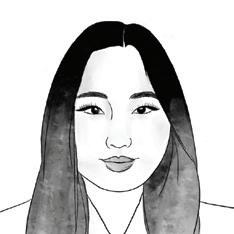
By Siyeon Lee Associate Opinion Editor
By definition, civil disobedience calls for breaking the law — and where laws are broken, court cases can understandably follow. But even if the protesters themselves were aware of this legal implication, it does not necessarily follow that the University’s or the court’s decision was a just one. We should view the upcoming Clio trial through this lens.
Civil disobedience laws are necessary and meant to be enacted, but they must be understood primarily as a tool for order rather than for justice. The reason why civil disobedience is prosecuted is not because the underlying action is morally right or wrong — it’s prosecuted simply because it is against the law. The University’s decision not to interfere with the criminal charges of Clio Hall’s occupants, then, should be viewed as something that should have been expected. However, grappling with the moral conditions upon which they were invoked is a wholly different question. Civil disobedience laws have been present all throughout history in groundbreaking activist efforts whose legacies we live with today. The enforcement of the law — an expected attempt at order — should not signal to Princeton students that the causes that were behind the sit-in — an attempt at justice — were any less legitimate. The fine line between the maintenance of order versus justice exists, and it is a line on which we should tread very carefully.
Siyeon Lee is a sophomore from Seoul, South Korea intending to major in History. She is an assistant Opinion editor at the ‘Prince.’ She can be reached at siyeonlee@princeton.edu.
Another reminder of why the
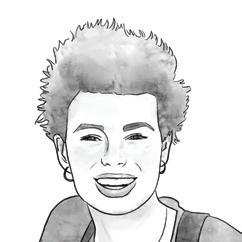
By Eleanor Clemans-Cope Head Opinion Editor
Today, six Clio Hall protesters were denied the plea deal that they sought. But this case should never have reached the courtroom: the University’s decision to give the municipal prosecutors full control over the prosecution of students during a protest that happened on University grounds was unnecessary.
The students were expressing their concerns within the context of the University community, and while there are reports of shouting, the protest was nonviolent. Princeton had the option to not involve town police at all — instead addressing the situation internally through its own disciplinary processes. Princeton has historically navigated these kinds of protests through negotiation, even when demonstrators occupied administrative offices. But even though this too was a disagreement between students and the administration, instead of handling it as an internal matter, Princeton involved municipal authorities.
The University’s decision not to pursue their usual approach this time may have deprived both the administration and protesters of the chance to learn and grow. By doing so, the University escalated what could have been an opportunity for dialogue and learning into a legal conflict. And this response — coupled with the other disproportionate and invasive punishment/ questioning of students — sets a concerning new precedent for how student expression is treated, raising questions about the fairness and predictability of disciplinary action at Princeton.
Eleanor Clemans-Cope (she/her) is a junior from Rockville, Md. studying economics. She is the head Opinion editor at ‘Prince.’ She can be reached on Twitter at @eleanorjcc or by email at eleanor.cc@ princeton.edu.
This whole case focuses on the wrong issue
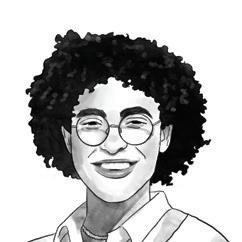
By Asa Santos Columnist
The case against the students at Clio Hall perpetuates the narrative that the worst thing that happened that day was what the student protesters did. This is harmful and undermines the real unnecessary aggression that the students themselves were subjected to at the hands of law enforcement.
Per the statement released by professor Ruha Benjamin, students entered the building with a polite “collective demeanor;” professor Benjamin doesn’t mention threatening or abusive behavior, but instead highlights the students’ “soft-spoken” nature. Staff, according to professor Benjamin, “walked out without incident.” This account clearly dismisses other accounts that students would have threatened administrators to force them to exit the building. The faculty’s expressed concern for students’ wellbeing was merited: protesters were arrested, ziptied and handcuffed, confined to a TigerTransit shuttle, and evicted from campus residence.
Beyond these physical punishments for civil disobedience, students suffered further threats to their wellbeing — beyond criminal charges, students face academic suspension, expulsion, and having their degrees withheld. Without a doubt, praying while handcuffed is a gross misuse of power, an undermining of students’ physical autonomy, but especially demeaning to students’ freedom of religious expression.
It’s clear that students were not treated justly, and it is not just to penalize students while not holding the administration accountable for their mistreatment.
Asa Santos is a columnist for the ‘Prince’ and a senior majoring in Anthropology from London and São Paulo and minoring in Gender & Sexuality Studies and Global Health & Health Policy.
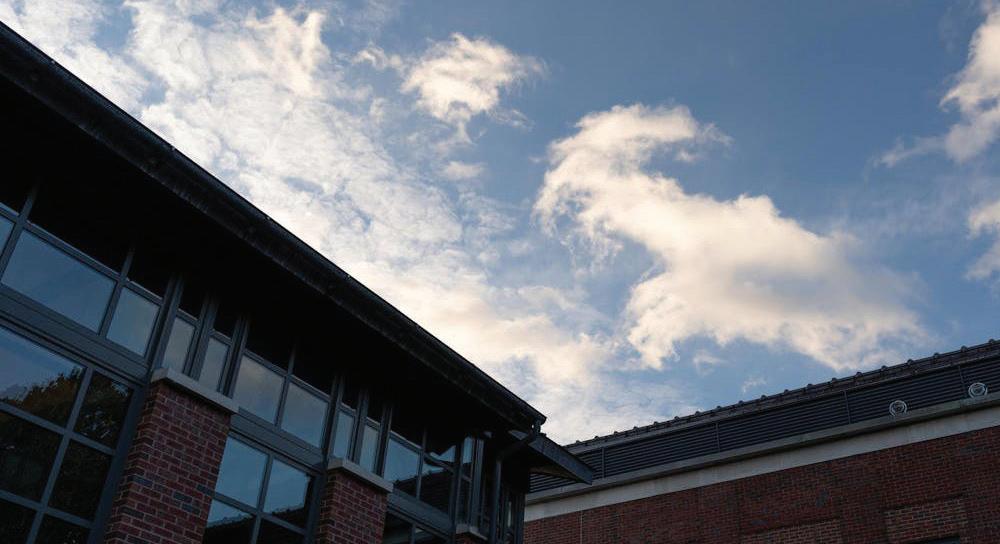
By Valentina Moreno assistant Features editor
“Most people are interested [in elections] like sports fans. You want to know who’s gonna win, and you’re rooting for your side,” explained Dr. Sam Wang, a professor at the Princeton Neuroscience Institute, from his office littered with books and notepads. “My interests are always different … Informed voters have more leverage than uninformed voters, and it’s my belief that the use of data will help them identify where they have leverage,” Wang continued.
Four years before baseball statistician Nate Silver rose to fame for predicting 2008 presidential election outcomes using his poll aggregator FiveThirtyEight, Wang’s Princeton Election Consortium (PEC) was among the first wave of models to use statistics and probability to predict close election outcomes.
“[Elections] are a game of probabilities,” Wang said. “I thought, ‘I have math abilities. Why don’t I help out with that?’”
Wang is a jack of all trades, master … of them all. At Princeton, he has affiliate appointments in the School of Public and International Affairs’ Program in Law and Public Affairs, the Center for Cognitive Science, the Program in Quantitative and Computational Biology, and the Center for Information Technology Policy.
The PEC is one of several projects Wang has created focused on what he calls “democracy repair.” In 2014, Wang launched the Princeton Gerrymandering Project, an effort to apply science to make redistricting more fair. PGP’s mission then expanded to include other problems in democracy, culminating in a multi-institution nonprofit, the Electoral Innovation Lab (EIL), housed in the municipality of Princeton. Since 2016, Wang has collaborated with History professor Julian Zelizer on a podcast, Politics and Polls. This summer, Wang and the EIL launched the VoteMaximizer, which calculates the power of individuals’ votes in elections all over the country, from the local to national level. All the while, he runs his own lab at PNI, which “investigates how brains learn from sensory experience, in adulthood and development, with relevance for autism.”
“My general idea is to apply science, data science, and statistics to really understand our complicated government and figure out where citizens have the most leverage,” Wang told the Daily Princetonian.
PEC v. FiveThirtyEight
Wang’s foray into politics started during a short stint on Capitol Hill. After completing his Ph.D. in neuroscience at Stanford, Wang worked as a postdoctoral fellow for the Senate Committee on Labor and Human Resources.
“I got really interested in that year’s presidential election, Kerry versus Bush. Ever since 2000, we’ve had a string of really close elections, with five of the last six
decided with a popular vote of five points or less,” Wang said. “When elections are this close, just a few votes matter, so I thought it would be interesting to aggregate all the data that was available at polling that year, to figure out where voters had the most leverage.”
Wang distinguishes the PEC from other aggregators like FiveThirtyEight, both in intentions and in the math used in the model for poll aggregation itself, creating a workplace rivalry between the two groups. In 2014, Silver tweeted about Wang’s prediction about the Senate race, “I would like to place a large wager against that guy,” to which Wang responded in his articles breaking down his poll analysis on the PEC.
Lucas Manning ’20, who worked on the PEC with Wang while an undergrad, noted that any rivalry or “quips” between the two aggregators are completely academic in nature and stem from different approaches to poll aggregation.
“Sam was more about looking at the polls and just aggregating them, and Silver’s model incorporates a lot of other factors, like inflation in the economy, that have shown to have an effect on the outcome of elections,” Manning said.
While Wang separates the PEC from counterpart FiveThirtyEight’s goal to drive “horse race coverage,” he also acknowledges the role that FiveThirtyEight has played in popularizing poll aggregation, including the PEC. In 2004, the PEC’s analysis of state polls got tens of thousands of hits per day, and since then, the PEC has recorded over five million visits. The PEC’s analysis has been featured on NPR and the WSJ, and in past elections, the New York Times’ Upshot has carried PEC’s work as part of presidential elections coverage.
As of Thursday, Sept. 26, 2024, the Princeton Election Consortium predicted a winning 279 electoral votes for Harris. The PEC also shows Republicans are currently favored to flip the Senate with 51 seats to the Democrats’ 49 seats. Democrats also currently lead Republicans by two percent in the House race.
From horserace to maximizing voter power
In 2012, the PEC correctly predicted the presidential vote outcome in 49 out of 50 states and Obama’s 51.1 percent winning popular vote. The PEC also correctly predicted 10 out of 10 close Senate races. In 2020, the PEC correctly predicted a Biden victory, but overestimated the winning number of electoral votes, both based on then-current state polling and if Trump outperformed the polling margin of three percent. However, in 2016, the PEC incorrectly predicted a 93 percent chance of a Clinton victory. Wang paid the price, eating a cricket live on CNN after losing a bet that Trump wouldn’t win more than 240 electoral votes.
Manning explained that the PEC’s popularity slightly dipped after the 2016 election.
“In the 2016 news cycle, the PEC
was considered one of the major aggregation sites by the New York Times, but I think the site’s reputation was damaged by the 2016 election,” Manning noted. “Compared to FiveThirtyEight’s prediction of a 79 percent chance of a Clinton victory, the odds of a one in three event are much easier to reason than a one in 100 event, so for those reasons, traffic in 2018 and 2020 was definitely smaller.”
Mark Tengi ’16, a computer science undergraduate who helped Wang maintain code for the PEC website during the 2016 election, explained that the PEC’s model of relying solely on the state polls contributed to an inaccurate prediction in 2016 because of a four percent error in the polls themselves. The PEC’s model differs from the methods of other aggregators like FiveThirtyEight, which included Silver’s own electoral projections based on demographics and prior voting patterns, creating a 79 percent chance of a Clinton victory.
“PEC turns polling data into win probabilities, but if that underlying polling data is inaccurate, then the whole prediction is inaccurate,” Tengi summarized.
Despite the post-2016 dip in popularity, Manning observed that this outcome pushed the PEC in a positive direction.
“I think the mission [of maximizing voter leverage] was driven largely by the outcome of the 2016 election — people were getting way too into the horserace of following elections and not really focusing on making a difference,” Manning explained. “[The model] became focused on helping people have more of an impact.”
Wang calls the principle of using math to identify how voters and donors can have the maximum possible leverage the “Democracy Moneyball” principle, a reference to Michael Lewis’s book “Moneyball: The Art of Winning an Unfair Game,” and playing on the public’s sports-like stake in competitive elections.
The “Meta-Analysis,” what Wang calls the math he uses for the Princeton Election Consortium, boils down to normal distribution as a measure for voter power.
Aggregating state polls, he takes an estimate of voter turnout for any given state, then estimates how likely it is that moving a few votes is going to make a difference by calculating the standard deviation, or the bell shaped curve. Tied races sit at the top of the curve, while those that are not tied are at the tails. Using this math, Wang has developed a single formula for per-vote leverage. Additionally, he includes a “meta-margin,” a quantity that corresponds to a virtual lead in a race.
Beyond the Princeton Election Consortium
Applying this same meta-analysis and “democracy moneyball” principle, Wang and others at the Electoral Innovation Lab have created the VoteMaximizer, a tool that identifies races and ballot initiatives from the local to the
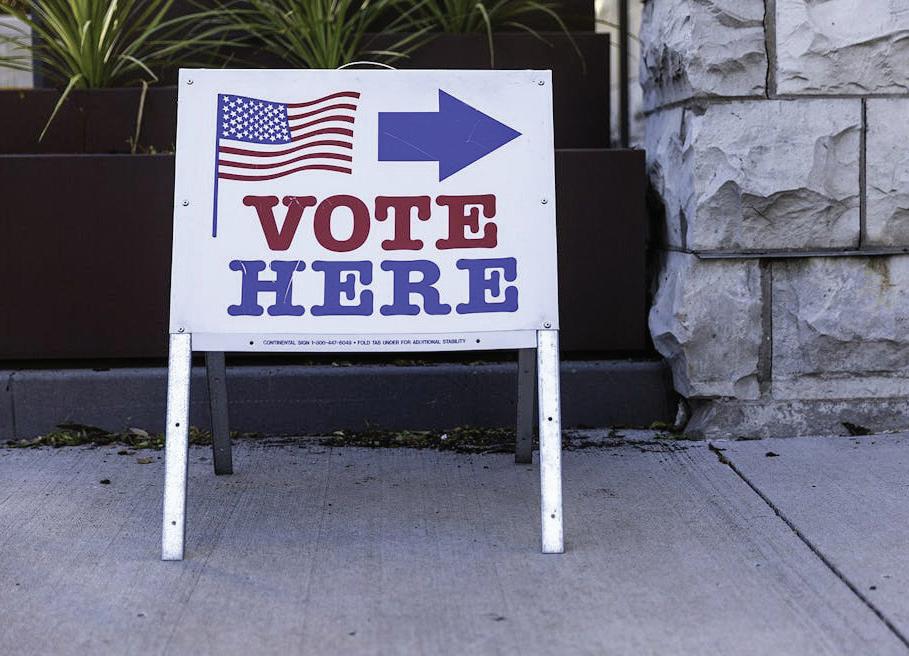
state level to maximize voters’ power and contributions. The tool identifies states and districts with high per-voter leverage. For instance, Nevada has a voter power of 98 because it is a swing state in presidential elections, has a close Senate race, and has close Congressional races.
“Voters in swing states have higher turnout than other states, and so it’s pretty clear that at the level of the presidential race, people pay attention to where they have more leverage,” Wang explained. “What we’re doing is calculating where that leverage is present at every level.”
Part of the work of the VoteMaximizer is to dismantle a common misconception among voters that votes only matter in presidential swing states. While doing data collection for the VoteMaximizer this summer, Lia Opperman ’25, found ways every voter, even Princeton students, can best leverage their voter power and contributions.
Opperman is the Director of Outreach for the ‘Prince.’
“There are contested elections in basically every state and ballot initiatives in most states,” Opperman said. “There is power that you have, an impact that you can make in your own area.”
In New Jersey’s Congressional race for District 7, the voter power is 65, where Democrat-hopeful Sue Altman aspires to oust incumbent Rep. Tom Kean (R-N.J.).
For the last year, Wang has also been collaborating with Professor of Ecology and Evolutionary Biology Simon Levin on a series of research papers about combating polarization through alternative voting systems, like ranked choice voting. Currently, Levin and Wang are working on a paper analyzing voting patterns to identify the degree to which voters are displayed along a single, one dimensional left-right axis, and the polarization along that axis over time.
Using statistical models to depict this polarization, Levin and Wang are examining how these voters on a left-right spectrum would have voted in alternative voting schemes like ranked choice voting and four primary voting.
“Our role is more to lay out for people what outcomes different voting schemes would have pro-
duced, and leave it to people to decide the outcome they prefer,” Levin said.
Levin and Wang both view the U.S. electoral college system elections as flawed.
“There are [currently] only a small number of states in which people’s votes matter … not just at the presidential level, but when you’re electing congresspeople as well,” Levin said. “That doesn’t seem fair to me.”
Part of the duo’s research is not only to uncover the value in alternative voting systems, but how they could feasibly be implemented through reform of local election procedures. Wang argues that voting for a third party candidate in a highly polarized election, like national elections, is an unproductive way to achieve this reform.
“I would love to have a roaring fire in my office. It would be lovely. But if I tried to do that without building a fireplace, then what I have is a burning office. The fire is the third party, and the fireplace is having, you know, rank choice voting,” Wang said. “And so the difficulty is that even though reform is boring, it’s how you get to having a better system.”
Levin echoes Wang’s sentiment that voting reform must be built from the ground up.
“I would say that both Sam and I are very favorable towards some form of ranked choice voting,” Levin said. “In dealing with environmental problems, we always say something like, ‘Think global, act local,’ and that’s what we have to do here: decide what’s the best system and then try and get it instituted in as many places as possible built up from the local level.”
While Wang and Levin work to find innovative solutions for democracy repair, Wang emphasizes the untapped power voters already have within the existing voting system.
“If voters knew how much power they had, it would increase their engagement,” Wang said. “What I’m doing is identifying where all those places are, not only for empowering them this year, but also making democracy stronger for years to come.”
Valentina Moreno is an assistant Features editor for the ‘Prince.’
By Isabella Dail | Head Prospect Editor
A line wrapped around the side of McCarter Theatre as dusk settled over Princeton’s campus. The people waiting chatted eagerly, some with their phones open and others clutching printed pieces of paper.
Everyone, whether with a digital or physical copy, had tickets in hand to see Laufey, a renowned Icelandic musician. Laufey was the top jazz artist on Spotify in 2022 and won a Grammy for the Traditional Pop Vocal Album in 2024. She has previously performed in venues like the Sydney Opera House and Radio City Music Hall.
However, this wasn’t a packed arena. Instead, Laufey was sitting down for a Princeton-exclusive event — a personal conversation with Anna Yu Wang, a Princeton assistant professor of music.
“I’m feeling so good. Thank you so much for having me. This is such a dream come true. I’ve always wanted to come and walk around this campus, and it’s so inspiring,” Laufey said in her opening remarks, joking that she wanted to “soft launch” Princeton as her new study spot.
The conversation wandered between Laufey’s upbringing in classical music, her breakthrough into improvisational music, her social media presence, and the impact of her cultural and familial background on her growth as a musician.
Laufey credits her background in classical music as informing her prowess in melody today; growing up, she played the cello and piano, instruments she practiced regularly after school. Yet, when she realized that she didn’t want to pursue classical music professionally, Laufey began to consider other avenues for a career in the industry.
“I still knew that I wanted to be a musician and I wanted to find a way to mix all of these different things together, but I hadn’t really found any artists to listen to or follow, and had mixed those worlds together. I guess I kind of just became that. It was a difficult journey for me because I became such a good rule follower through classical music,” she said.
Improvisation — a key component of the jazz genre that Laufey now embraces — did not come so easily after her start in classical music.
“I was mortified. I was so scared every week, and I’d sit in a practice room just trying to figure [improvisation] out, and I barely knew where to start,” she said when asked about improvising for the first time publicly, an experience she faced as an undergraduate at the Berklee College of Music.
As the conversation unfolded, Laufey began to diverge into her identity and its influence on her decisions, particularly as an artist. Laufey is Chinese and Icelandic, and she grew up
splitting her time between Iceland, the United States, and China.
“I think being straddled in so many cultures has been such a good thing for me as a musician, because now, I get to travel the world and tour the world, and I’m so innately aware of how big the world is and how many people there are. There isn’t just a group of 400,000 people on an island … that’s Iceland,” she said.
Bringing Laufey to campus was a group effort involving several parties, particularly Princeton Encore and McCarter Theatre.
Princeton Encore, founded by Simon Marotte ’26, is a group that looks to bring wellknown artists to campus for Q&A conversations.
been a fan of her for a while because I love jazz, and I play piano, and I really appreciate what she’s doing,” Marotte told the ‘Prince.’
According to Marotte, it took about a year of pitching and negotiating to bring Laufey to McCarter. In the future, he hopes to see her visit campus again and continue a conversation about her music.
” “
“I was interested in having intimate Q&A conversations … I would love to see artists come and talk about their lives and not just perform,” Marotte told The Daily Princetonian.
I’m feeling so good. Thank you so much for having me. This is such a dream come true. I’ve always wanted to come and walk around this campus, and it’s so inspiring - Laufey
Marotte is a former head Puzzles editor for the ‘Prince.’ Laufey’s arrival was also a sizable undertaking for McCarter Theatre, both in the process of booking Laufey and the ordeal of preparing the theater for her arrival. The bulk of responsibility was directed to Arts & Ideas, a program housed within McCarter’s services that “connects Princeton University scholarship, campus life and community partners to the work on our stage and behind-the-scenes.”
ming at McCarter Theatre, broke down the logistics of booking an artist like Laufey in more depth.
“I reached out to the agent. It was a longshot,” she said. “[W]e have these relationships with agents and reps and that makes a difference … when you already have an established relationship, it cuts through a layer. It was actually a quick response,” Abreu told the ‘Prince.’ From there, negotiations about fees and dates began. Abreu also noted that McCarter had to gear up the theater to prepare for Laufey’s arrival.
“McCarter may have worked with artists like this before, but it’s rare that this sort of relationship happens, and it’s delicate in the sense that they come with many more requirements. This informs things like, what does the security look like at our theater, things that we usually don’t have to pay very deep attention to,” she said to the ‘Prince.’
Yet for many audience members, the logistics were worth it, especially with the surprise miniature concert that concluded the event. Laufey slung a guitar over her shoulder and approached a standing microphone. She sang two songs: “Bored” and “From the Start.” The theater became alive as students raised phones to record and sang softly along with her.
Marotte brought a list of dream guest artists to the staff of McCarter, and the team began working on pitches. Laufey, not on Marotte’s original list, came into the fold later.
“For some reason, she wasn’t on the initial wish list. I don’t know why I was not thinking of her … she would be perfect for Princeton because she’s dubbed as Gen Z’s jazz icon. So many members of my generation love her, and I’ve
“We’re a smaller venue than Radio City, and we get major artists here,” Debbie Bisno, Director of University and Artistic Partnerships at McCarter Theatre, told the ‘Prince.’
“We knew that we were going to have to be competitive in a different way … it’s not easy to book the people that we book … and one of the things we can offer is direct and authentic engagement with students and campus,”
Paula Abreu, Director of Presented Program-
Students chanted “blah, blah, blah” along with Laufey, some of the more playful lyrics of “From the Start.” During her performance, Laufey also twisted a lyric or two, telling Princeton she “loved [them] from the start” in some of the last lines of her performance.
Her exit, where she wished students a great semester before leaving the stage, was met with a standing ovation.
Isabella Dail is a staff News writer and head editor for The Prospect for the ‘Prince.’
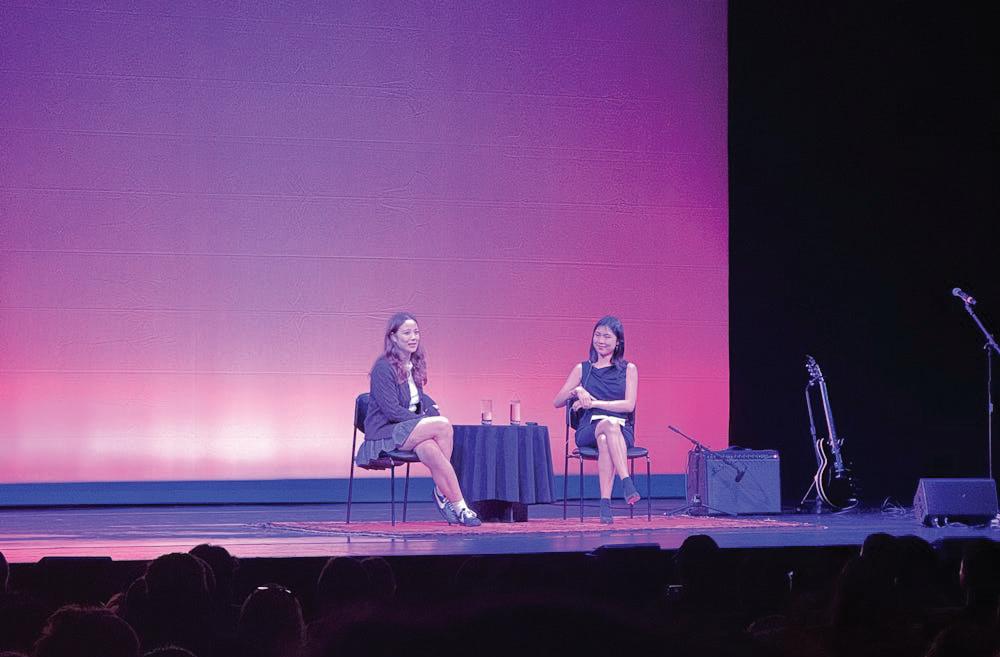
By Gavin McLoughlin
Prospect Writer
It feels practically empty. Sitting beside a small assortment of students under the buzzing red sign of Cafe Vivian, I can hear sparse footsteps pacing across the floor. Every few moments, the silence is broken by an outburst of joyous laughter from students enjoying the final hours of their weekend.
Here, at Frist Campus Center, I sat down with Roya Reese, a junior in the English Department. Since her first year, Reese has performed at Coffee Club, delivering an incredible range of styles and genres. I spoke with her to discuss her experience with music at Princeton, musical influences, and advice for future student musicians.
This interview has been lightly edited for clarity and concision.
Daily Princetonian: We’re doing a student series on student musicians on campus. You were one of the first names that were brought up.
Roya Reese: Oh, my god, that’s so cool.
DP: So, can you tell us a little bit about yourself? How did you start out with music? And, what style or genre do you usually
perform?
RR: Well, I’m a junior, I’m in the English department, and I’ve been playing piano and guitar since I was in third grade. My parents put us in lessons, and I sang a lot in high school, and then I saw someone playing at Coffee Club freshman year. And I was like, that’s really cool. So I sent them a video, and they said, ‘We’ll just slot you in once a week.’ So I just play for an hour, and I do half guitar and half piano. I don’t write my own music, so I just play covers.
DP: What type of genres do you usually perform?
RR: I mean, honestly, anything that sounds good acoustically. So, more like Taylor Swift, Phoebe Bridgers, boygenius. I play some older stuff like Indigo Girls, James Taylor. Kind of the same music that I listen to.
DP: Cool. The second question I have is, where is your dream venue to play?
RR: On campus?
DP: On campus.

RR: I’m in Terrace, so I would love to do a Tap night on Thursday night, but I don’t play with a band or play super ‘hype’ stuff, so it’s maybe not the right vibe, but I would totally do something like that.
DP: That’d be sick. Have you ever played with a band before?
RR: I haven’t really. I’ve played with an orchestra. I did musical theater in high school. So I’ve definitely, like, sang while people play, but not really with a band.
DP: That kind of leads me into my next question: If you could have any guest performer, who would it be, and why?
RR: Oh, that’s a good question. Probably someone who plays their instrument really well. I’m trying to think, maybe Prince?
DP: That’s a great choice.
RR: He would play guitar. He’d be back up.
DP: Have you ever seen his solo at the Rock and Roll Hall of Fame?
RR: Totally, yes. I wouldn’t even do anything. I would just stand there and let him just take over.
DP: What would you say some of your greatest influences have been?
RR: I’m classically trained, so I studied opera and classical voice in high school. I’ve seen a couple things at the Met, and I feel like the way that they are able to project into the space is cool. But also, just anybody who I’ve seen play at Coffee Club. It’s more about creating a vibe than about if you sound good, or what you’re playing. You want to play chill stuff so that people can enjoy their coffee and do their work. So a mix of that, and just my family. We do music events where we all just sit together and play.
DP: You said that you were involved in theater before coming to Princeton. Did that change your perspective on music and the type of music that you performed and liked?
RR: I make a set list every week before I
and feta croissants in their order from Delizioso.
The continuous chatter of the lunchtime rush floats around the corner-lot cafe and bakery of Delizioso. The woman behind the counter, Lynne, converses with a customer-turned-close friend. A man, Eric, greets a steady stream of hungry businessmen by name, rattling off inside jokes and anecdotes. Meanwhile, bursts of laughter, the crunches of perfectly-crispy sandwiches, and the faint clatter of pans in the kitchen all add spice to the sweet air that fills Delizioso, Coffee Club’s new pastry provider.
In March 2020, Eric and Lynne Weshner, husband and wife and owners of Delizioso, envisioned an eatery centered around a love for food and the joy it brings to people. By May 2021, renovations on 205 Witherspoon Street were complete and Delizioso opened its doors to the Princeton community. Eric, a former NYC Police Department detective, and Lynne, a former nurse, had no formal training in running a bakery. However, they knew that leaning on their support system of customers, both old and new, would allow them to turn their vision into reality. By catering to the community, local offices, and the University, Delizioso seems to have achieved that vision for their business.
In September 2024, Coffee Club reached out to Delizioso with hope that they would become the student-run coffee shop’s new pastry provider.
“I was astonished and honored,” recalled Eric. Delizioso’s owners take pride in this recently established collaboration. Eric mentioned that he and his staff now come in earlier to fulfill Coffee Club’s order and, most importantly, to bake pastries the same day they are delivered.
“We don’t make stuff the night before, everything is fresh,” he added.
The quality of baked goods is important to Delizioso, which is already evident to Princeton’s Coffee Club aficionados. Students have been exceptionally pleased with Delizioso’s pastry selection. Coffee Club has even requested an increased supply of spinach
While visiting the bakery, I opted for “The Isa” sandwich to try out a lunch item that is not available at Coffee Club, but offered at Delizioso’s storefront location. The sandwich contained the classic sandwich ingredients of avocado, lettuce, and tomato, along with pepperjack cheese, potatoes, and scrambled eggs to add a rich, savory component — all of which were wedged in a kaiser roll. With each bite I took, I relished each unique flavor that blended together under the warmth of the sandwich. I also had the pleasure of trying a chocolate chip cookie. It was a large, thin cookie containing scattered chocolate chunks that did not make it overwhelmingly sweet. Apart from these items that I tried, Delizioso’s menu contains a plethora of dietary-friendly options including vegetarian, vegan, gluten free, or dairy free dishes spanning from scrumptious baked goods to hearty, savory meals.
“It’s all about community,” Eric said of his and Lynne’s mindset for running Delizioso. “We love food and we love people.”
The couple is proud of the rapport they have built with Princeton students. In fact, Eric and Lynne are strong supporters of the University and often attend Princeton sporting events. They especially love it when student-athletes visit Delizioso with their parents. Eric reflected on members of the 2024 Summer U.S. Olympic team who were once Princeton rowers and would frequent Delizioso for a morning treat after a tough workout on Carnegie Lake.
“We’ve always wanted to come to a neighborhood and be an anchor in the neighborhood,” he noted.
This meaningful community presence extends to the Princeton residents as well: Eric and Lynne have continually befriended customers, even later attending some of their weddings and birthdays. Additionally, they invest in other Princeton small businesses by sourcing eggs and vegetables from local farms.
With the introduction of Delizioso’s goods into Coffee Club, it is evident that each cafe’s values align with and amplify one
play. So normally if I don’t feel super happy, then it’ll be a sadder setlist. It’s more just that if I don’t feel connected to the song or the vibe of it, then I probably won’t play it.
DP: Okay, so you change the set list week to week based on how you’re feeling?
RR: Yeah. And this season they [Coffee Club] did their fall drink launch on Friday, and so I played a lot of Noah Kahan and some Taylor Swift “Red” stuff. That’s very fall.
DP: How do you plan on continuing to incorporate music into your life once you graduate?
RR: Well, my brother wants to be a musician. My family’s moving to Nashville in two years, and so I think he wants to kind of pursue it a bit there. He’s bigger than me, so I’ve helped him. I’ve sung on some of his stuff, but I’d love to do open mics. Honestly, wherever I end up, it’s not something I would ever do professionally, just because I feel like that would kind of take the fun out of it. But it is nice. I also feel it connects me to my family more because my grandparents and my parents really like to hear me play. I know I’m not the most amazing singer or guitar player or piano player, but if it makes them happy, then that’s a nice way to connect.
DP: As a final question, what would you tell student musicians at Princeton who want to perform, but don’t quite have the courage to do so yet. Do you have any advice for them?
RR: It’s kind of counterintuitive, but nobody’s really paying attention to you, even at a tap night at Terrace. Yeah, they’re watching you, but what they really want to do is dance and have fun. So you’re just kind of creating the vibe in the atmosphere, as opposed to people staring at you and wanting you to fuck up. It’s just not that deep. Do your thing.
DP: Perfect. Thank you so much.
Gavin McLoughlin is a member of the Class of 2028 and is a contributing writer for The Prospect. He can be reached at gm9041@princeton. edu.
another. The atmosphere of Delizioso mirrors that of Coffee Club; like Delizioso, the community at Coffee Club is one of close companions and great food. At either of Princeton’s Coffee Club locations, it is easy to imagine a mid-day study break, where one might pass by a table of dedicated math students discussing a p-set. The baristas are fellow students, and the customers are old friends that are catching up while waiting for a coffee and chocolate croissant. At Coffee Club, like Delizioso, the taste of community and tasty food is savored in each new bite. So, the next time you are out in town, stop at Delizioso for a bite. And if you can’t quite escape campus, make sure you get a taste of Delizioso at Coffee Club.
Ysabella Olsen is a member of the Class of 2028. She is a contributing writer for The Prospect and copy editor at the ‘Prince.’ She can be reached at yo7647@princeton.edu.
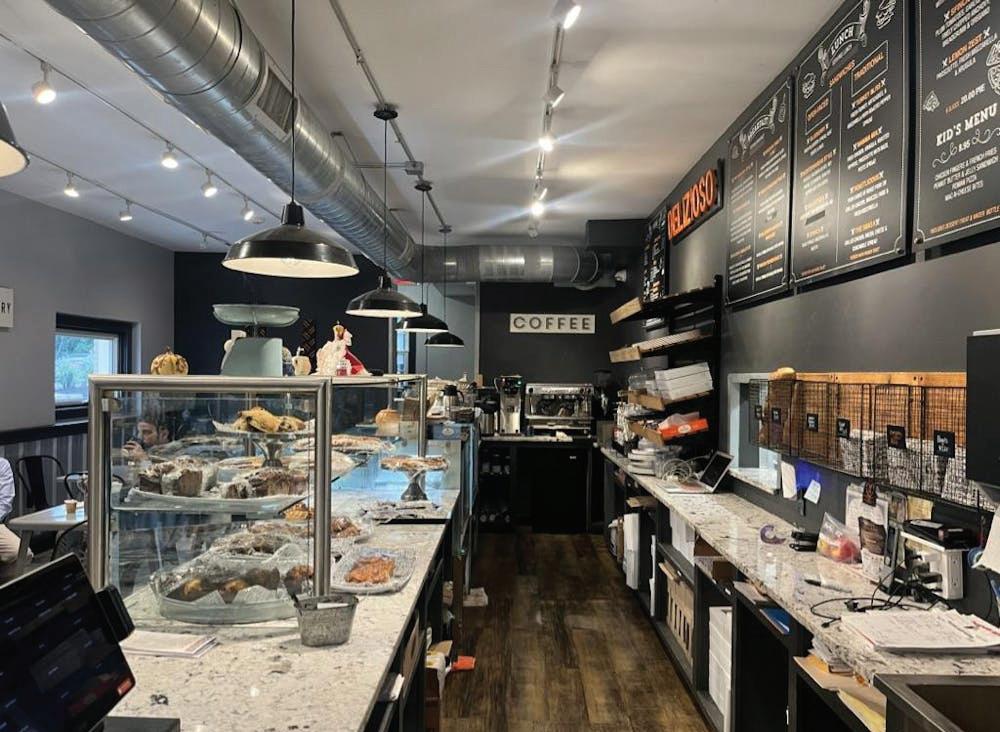
By Princess Fodeke, Contributing Writer for the Prospect
Princeton African Students Association (PASA) First-Year Feast
Oct. 5 at 6:30 p.m.
Carl A. Fields Center MPR 104
Come celebrate with the Princeton African Students Association at the First-Year Feast. Connect with upperclass students while engaging in important conversations and eating delicious food. This event is free and open to all Princetonians.
Oct. 9 at 5:30 p.m.
Princeton University Chapel
In the Footsteps of Bartók: Collaborations and Improvisations
Oct. 7 at 7:30 p.m.
Taplin Auditorium, Fine Hall
Join Princeton faculty violinist, Anna Lim, and her colleagues from Klasik Keyifler and the Hoppa Project, as they follow the footsteps of renowned composer Béla Bartók. This event is free and open to the public.
Princeton University Orchestra: Peter Westergaard Concerts
Oct. 5 at 7:30 p.m. and Oct. 6 at 3 p.m.
Richardson Auditorium, Alexander Hall
Michael Pratt will conduct the Princeton University Orchestra as they present their first program of the 2024–25 season. Kasey Shao ’25, who won the 2023–24 Concerto Competition, will perform George Gersh- win’s “Rhapsody In Blue.” Tickets are required and cost $15 for the general public and $5 for students.
Oct. 8 at 4:30 p.m.
Richardson Auditorium, Alexander Hall
“Conversations on Art-making in a Vexed Era” is a discussion between Pulitzer Prize-Winner Annie Baker and composer Kamala Sankaram about the challenges of making art in the modern world. This event is free and open to the public.
5 6
Tune in to sound healing practitioner Ruth Cunningham, a founding member of the Anonymous 4, for a sonorous music performance. This composed and improvised music is useful for meditation, prayer, or purely just contemplation. This event is free and open to the public.
Princeton University Concerts presents Cécile McLorin Salvant, Vocals, and Friends
Oct. 9 at 7:30–9:30 p.m.
Richardson Auditorium, Alexander Hall
Jazz vocalist Cécile McLorin Salvant, comes to Princeton with a “fusion of Baroque music, vaudeville, Sappho, and folkloric material of Europe and the Americas.” Dive into Salvant’s folk to a world of blended genres that create a unique experience sang by a legendary artist. Tickets are required and cost $35–$60 for the general public and $15 for students.
8
NASA Launch Watch Party: Europa Clipper
October 10 at 11:30 a.m.
Fine Collaboration Hub, Lewis Science Library
Watch the launch of the Europa Clipper, NASA’s largest spacecraft ever, with fellow students and colleagues. The mission’s goal is to determine whether Jupiter’s moon Europa could support life. No tickets or RSVP are needed.
A Thread of Golden Ashes by Le’Naya Wilkerson
Oct. 4 at 8 p.m., Oct. 5 at 8 p.m., and Oct. 6 at 2 p.m.
Wallace Theater, Lewis Arts complex
9
7 10 11
The play “A Thread of Golden Ashes” depicts a poignant story of love and loss. Written by Le’Naya Wilkerson ’25 and directed by Wasif Sami ’25, it explores how the memory and presence of lost loved ones may linger for longer than expected. This event is free and open to the public, but advance tickets are required.
Ken Cowan in Concert Princeton University Chapel
World-class musician and organist Ken Cowan performs at the University Chapel. He is one of the most sought- after concert organists in the United States. No tickets or registration are required and the event is open to the public.
Crafternoon: Stitch a Mini Embroidery Sampler
Oct. 10 at 12:30 p.m.
Discovery Hub, Firestone Library
Drop by the Discovery Hub to learn basic stitches with a sampler embroidery pattern. Registration is free and optional, but encour- aged. This event is open to all members of the Princeton community and all supplies are provided.
Carolin Meister, The Last Voyage
Oct. 9 at 6:15 p.m.
East Pyne Building, 100COR Upper Hyphen
Join this reception for Dr. Carolin Meister, a short-term Fellow for the Humanities Council. This talk follows Dr. Meister’s film studies lecture on Marcel Broodthaers’ “The Last Voyage.” This event is free and open to the public.
By Diego Uribe & Tate Hutchins head Sports Editor & Associate sports editor
Sophomore Matteo Torres vividly remembers visiting Princeton as a middle schooler, though it wasn’t Nassau Hall or Blair Arch that caught his attention.
“We drove past the lake with the [crew] team practicing on it,” Torres said. “I said to my family that when I go to Princeton, I wanted to row.”
Torres joined the lightweight crew team by walking on rather than going through the traditional recruiting process. Despite finding a home in the boathouse months after his teammates, a large part of Torres’s Princeton life revolves around Lake Carnegie.
“This is my third year on the team, and I feel like I’ve been completely integrated into the team,” Torres said. “My teammates are some of my closest friends, and I can’t imagine my Princeton experience without them.”
Torres is a former News contributor for the ‘Prince.’
His path mirrors that of many Princeton student athletes who have taken up varsity sports after their first-year orientation. While these athletes may not be at the caliber of their recruited peers, they fill a crucial niche in the locker room — adding depth to the rosters of Princeton’s 38 varsity sports teams.
Around 18 percent of Princeton students play a Varsity sport, which is substantially more than peer institutions like Harvard at 11 percent, Stanford at 12 percent, and Brown at 13 percent. However, this figure includes walk-ons like those that are profiled here, and many of the other 80 percent or so of students have backgrounds playing sports. According to the 2027 Daily Princetonian Frosh Survey, 52.5 percent of incoming first-years took part in varsity athletics in high school.
No matter the sport, having competed at a high level in high school is a requirement to walk on. For example, the Princeton men’s swim and dive recruited vs. walk-on consideration is just 0.4 seconds apart in the 50 freestyle, roughly the same as the range across the Olympic finals this year.
Though Torres found his calling in the swimming pool in high school, he took to the water in a different way after arriving at Old Nassau.
“I was a swimmer in high school, so when I got to Princeton and was reintroduced to the idea of rowing, I had the athletic background to join.”
Much like Torres, junior goalkeeper for men’s soccer Sully Atkin knew he wanted to play at the Division I level from a young age. Atkin grew up playing for the Alexandria Soccer Association — one of the top
programs in Virginia — and was in goal for a regional champion high school.
“In high school, I knew I wanted to play college soccer, but I also knew I really wanted to go to a really good academic school. So, I basically dual-tracked it,” Atkin told the ‘Prince.’ “[College soccer] seemed like something I might be able to do based on … the teams I was playing on.”
“[Princeton] said that they didn’t see me as part of the recruiting class, but they do have a walk-on process,” Atkin continued. “So, if I get into the school on my own, just send them an email, and then we can talk about a potential walk-on process.”
However, there’s wanting to play a college sport, and there’s the reality of making a college team. Princeton’s 38 varsity sports all compete at the Division I level and have racked up the most Ivy League championships of all schools in the storied conference over the last two decades. Due to such a high level of expectation for each sport and the lack of many openings, getting in is difficult.
“After I got in and committed to Princeton in April, I sent the coaches an email reintroducing myself and letting them know I got in, and [that] I’m still definitely interested in a potential walk-on process. And then they invited me to preseason,” Atkin said. “It was unclear when I first came whether or not I was on trial, or what the deal was.”
Now three years later, Atkin is a crucial part of the team.
“They contribute with their play on the field and with their character on and off the field,”
Head Coach of Men’s Soccer
James Barlow wrote to The Daily Princetonian in reference to
walk-ons. “They have a voice, their opinions and thoughts are heard and respected, and they help make our culture better both on and off the field. Some of our walk-ons have become very important team leaders.”
Princeton soccer has been at the core of Atkin’s Princeton experience ever since. “I’ve met some of my best friends on the team; I wouldn’t change a thing,” he shared.
Though Atkin didn’t know it at the time, his spot was secure upon arriving at campus for preseason as a first-year.
“For some players who we are able to watch and evaluate and get to know before they arrive to campus, we may know that they are good enough to be on the team, and we may offer them a roster spot for preseason,” Barlow wrote about players in Atkin’s position. “For others, we may offer them a chance to try out,” he added.
Torres arrived on campus in a very different context — his spot had yet to be earned.
“During the first week of class my freshman year, I attended an info session about walking on to the team and promptly started the process,” Torres said. “It was a two-month process of daily training and test workouts with the other potential walk-ons, where they made regular cuts until just a few were left.” Now, Torres is a rower through and through and lives with several of his teammates.
Outside of a cap of 120 players every four years for football, there are no set limits on Princeton recruiting. According to former Dean of Admissions Janet Rapelye, though, coaches and admissions officers often face pressure to limit the number of recruits due to the already small number of
spots available in each incoming Princeton class. As such, walk-on athletes like Atkin and Torres play a valuable role by essentially freeing up recruiting spots and adding depth to varsity teams.
Though some teams like soccer use walk-ons to fill bench spots, where players rarely see extensive time on the field, the role of the walk-on can vary. In fact, walk-ons form the backbone of some Princeton teams.
Women’s rugby is currently competing in just their third season as a varsity sport.
“We wouldn’t have a team without our walk-ons — they have been the heartbeat of our program as we’ve transitioned into Varsity,” Head Coach of Women’s Rugby Josie Ziluca wrote to the ‘Prince.’
“The walk-on players provide different perspectives on how to approach challenges, which has our team prepared for many tests and trials along the road of their four year journey,” she added. “They also provide inspiration and confirmation to folks who are curious about rugby, providing examples of people learning the sport for the first time to earning a starting position in a NCAA Division I league.”
For women’s rugby, which hosts open walk-on tryouts every fall and invitational tryouts each spring to fill out their roster for the season, the confirmation that truly anybody is welcome is critical.
“There’s a playing position for every body type out there, and through the training and skill-set building in a safe, fun environment, you’ll learn a lot about yourself too,” Ziluca wrote.
Developing walk-ons to start — and star — on a Division I varsity team is difficult; stu-
dents who were unfamiliar with the rules just a year before face opponents who were recruited to play at a high level. There have been growing pains as the Princeton rugby squad, which played at the club level just a few years ago, faces opponents like Dartmouth, who heavily recruit their full team.
But their start this year has proved that their player development model does in fact work. This past week, they notched their first varsity win over Bowdoin, ensuing a massive celebration and proving that walk-ons can indeed find success — even with only a select few recruits on the team.
Walk-ons play for the sake of playing. Through varsity sports, many of these athletes get to pursue their lifelong passions as a part of the centurieslong tradition of Princeton athletics. Little slack, however, is cut for these non-recruits.
“The expectations are exactly the same with the recruits and walk-ons, and the treatment is exactly the same,” Atkin said. And getting walk-ons into playing form, despite their athletic background, is no easy task.
“It’s a monumental challenge to prepare a walk-on athlete to have the mindset, courage, and skill sets to safely play against teams with rosters full of recruited players,” Ziluca wrote. “But when walk-ons can commit themselves to controlling those items and show up to get better every day, amazing things happen for them.”
Diego Uribe is a head Sports editor for the ‘Prince.’
Tate Hutchins is an associate Sports editor, staff Audience creator, and News contributor for the ‘Prince.’
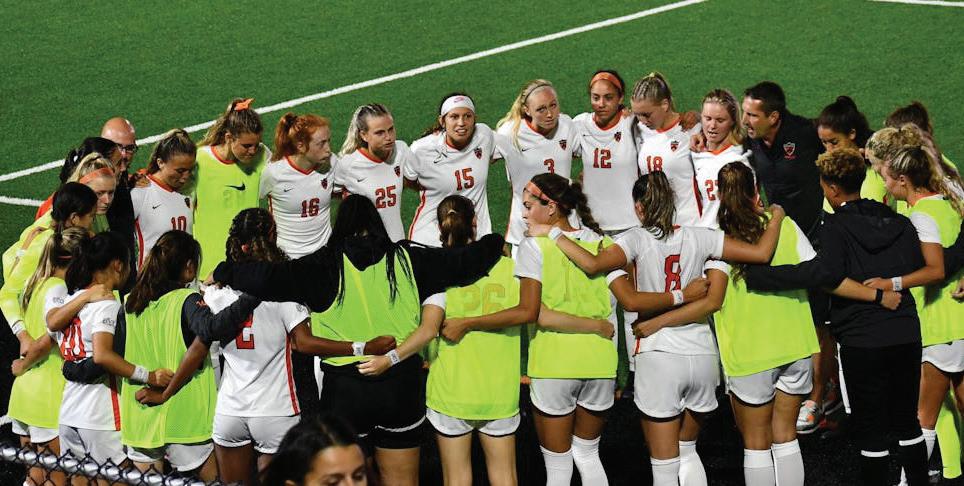
BY THE NUMBERS
By Harrison Blank & Amrit Vignesh Assistant Sports Editor & Sports Contributor
Each week, Sports and Data writers analyze recent athletic competitions to provide analysis and insight on the happenings of Princeton athletics and individual players across the 38 intercollegiate teams at Princeton. Whether they are record-breaking or day-to-day, statistics deliver information in concise ways and help inform fans who might have missed the action. Read past By the Numbers coverage here.
Princeton Tigers: Sept. 20–Sept. 26
Twenty-six games and matches were played across nine sports and six U.S. states and the District of Columbia over the past week. Of the 12 games where only one team came out on top, the Tigers won 42 percent of matches, less than the 50 percent they won in their first week of competition. The Tigers performed far better at home than away, cruising to victory in their only home game — women’s rugby — while clinching a win only 36 percent of the time when on the road.
Multiple-day meets and tournaments are counted individually for each day of the competition. Competitions with more than one event or individual results such as golf and cross country are not included in our win percentage analysis.
Get low, get low
Riccardo Fantinelli continued his elite ball striking and talent around the pins this past weekend at Duke, shooting a school-record seven
under par for men’s golf in the third and final round of the Rod Myers Invitational. The Rome native scored four straight birdies to storm up the leaderboard to finish tied for third.
“It’s also nice to shoot a low score on the final round and Duke’s golf course really suits my shot shape off the tee,” Fantinelli wrote to the Daily Princetonian. He attributed his hot finish to his putting and said he was “just glad I was able to stay patient.”
From Paris to Piscataway
Beth Yeager, a member of the USA field hockey team this summer in Paris, proved her Olympian pedigree by earning Ivy League Player of the Week. Yeager scored three goals and recorded two assists across the Tigers’ two wins over crosstown rivals, Rutgers and Penn.
Murder on the gym floor
After receiving the Ivy Player of the Week award last week for amassing 52 kills across three games, Kamryn Chaney had the most kills in a match by an Ivy League volleyball player in ten years at 34. Chaney’s rash of kills came at a .484 hit rate in women’s volleyball’s win over High Point University.
The summer of ’59
After going scoreless in a 93–0 loss to Dartmouth last weekend, women’s rugby earned their first program victory as a varsity team by beating Bowdoin 59–0 this weekend. Sophomore wing Celia Watson led the way with three tries and sophomore utility back Malinka Kwemo went seven for nine on kicking conversions.
“We were all super excited to get our first varsity 15s win; we’ve been working towards this goal since we first turned varsity, and it feels like all the effort and time that we’ve dedicated towards skillwork, watching film, taking care of our bodies, getting faster ... was finally paying off,” junior scrum half Kenzy Elshalzy wrote to the ‘Prince.’
She credits the team’s hunger for a win to the dominant final score.
“The difference is how much you want to win, and we wanted it so bad that we poured all of our energy out.”
Corner coroners
Men’s soccer has had an on and off start to their season so far this fall, opening with a 2–3 record; however, they currently lead the Ivy League in corner kicks per game. Clearly, the scoring opportunities are there, and it won’t take long for the goals to follow from junior midfielder Jack Jasinski’s high arcing entry balls.
Lack of quarterback attack Princeton football struggled in their opening 35–20 loss at Lehigh in all facets of the game, from punting to the line of scrimmage, but the quarterback play was a major factor. Senior Blaine Hipa had a tough go of things in his first career start, grading out at the lowest passer efficiency of all eight Ivy quarterbacks in their first week.
California dreamin’ of hat tricks
No. 7 men’s water polo ended their weekend trip to the West Coast with a 14–12 victory over No. 10 Long Beach
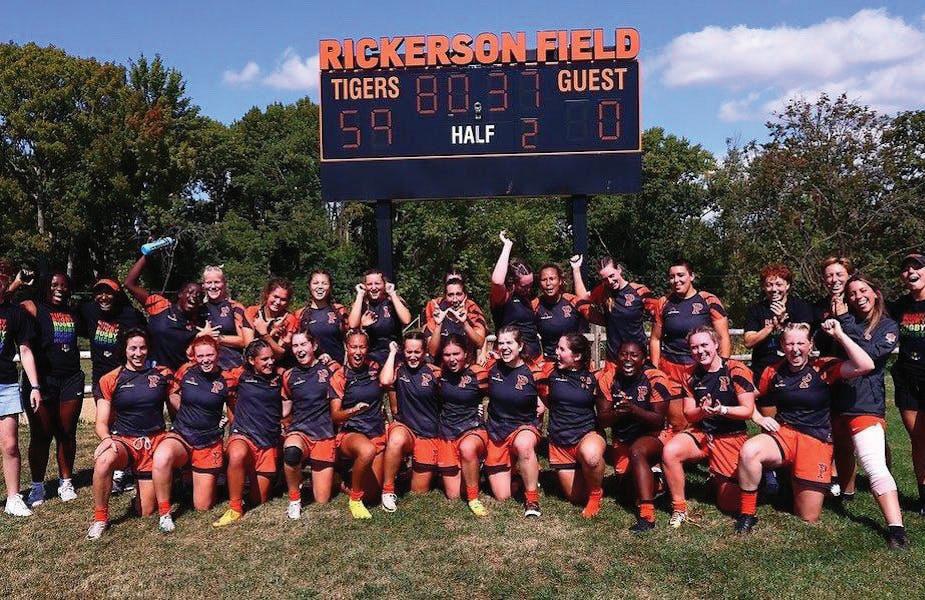
State University, headlined by two hat tricks by upperclass students. Junior and senior utilities Luke Johnston and Roko Pozaric each notched three goals in the team’s first top-ten win of the season.
“We are literally getting better every weekend, and we know we just need to stay consistent with that,” Johnston told the ‘Prince’ postgame. The Tigers went two for four on the weekend foray to California.
All in all, it has been a week of traveling for the Tigers, especially for men’s water polo. As the semester progresses, fall sports will start to transition into conference play. Check back next week to stay updated on all things Princeton athletics — by the numbers.
Harrison Blank is an assistant Sports editor for the ‘Prince.’ Amrit Vignesh is a Sports contributor for the ‘Prince.’

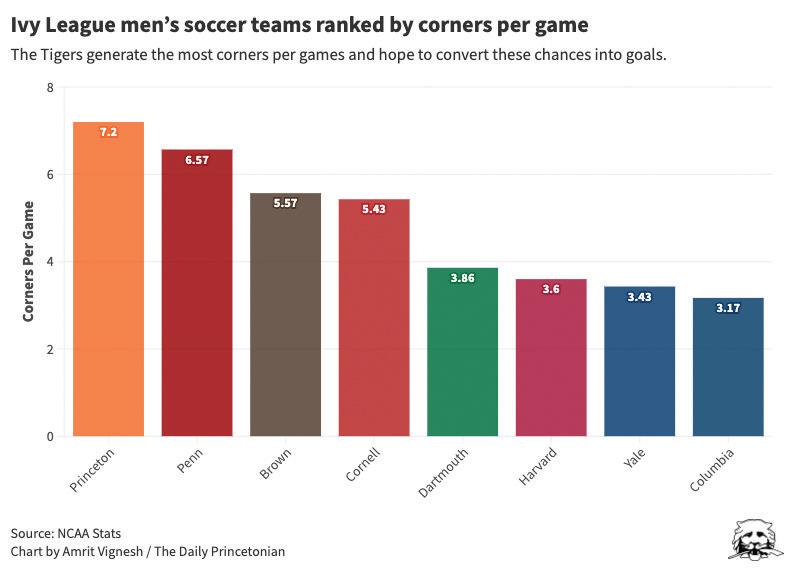

By Joe McGonigle Sports Contributor
After last week’s discouraging loss to Lehigh, Princeton football was faced with questions about their ability to beat quality opponents.
“I feel like the confidence never really left us,” junior defensive back Tahj Owens told The Daily Princetonian.
After this week’s commanding win against Howard, confidence won’t be going anywhere.
On a rainy Saturday afternoon, Princeton football (1–1 overall, 0–0 Ivy League) took on the Howard Bison (2–3 overall, 0–0 MEAC) in the firstever matchup between the two programs. Princeton was without their week one starting quarterback, junior quarterback Blaine Hipa. Hipa, who was injured in last Saturday’s game, was not cleared to play on Saturday until after practice on Thursday.
“All our top three quarterbacks get a ton of reps [in practice],” Princeton head coach Bob Surace ’90 told the ‘Prince.’ “I wasn’t going to play Hipa without practice.”
With Hipa’s injury, senior quarterback Blaine McAllister found out that he would officially be the starting quarterback on Friday, the day before the game.
“In practice, I’d been taking the first team reps, so I was mentally preparing the whole time,” McAllister told the ‘Prince.’ “But I mean, to finally get that confirmation was probably one of the most exciting moments of my life.”
Princeton’s offense got off to a quick start, largely because of McAllister’s running ability, and marched into Howard territory in four plays. Soon after, a hard count forced Howard to jump offsides, giving Princeton a free play. Penalties would become a recurring theme for Howard throughout the game. McAllister capitalized on Howard’s mistake, connecting with senior wide receiver Luke Colella on a perfectly placed 37-yard deep touchdown throw to give Princeton a 7–0 lead.
“Threw the ball up to [Luke Colella], and I knew he was gonna come down with it,” McAllister told the ‘Prince.’ “That was my first completion ever. It was that touchdown.”
After the opening drive, Princeton’s defense forced a punt. The punt, kicked by Howard quarterback Jaylon Tolbert, pinned the Princeton offense at their own one-yard line. After an incompletion on third down, Princeton gave the ball back to Howard with an impressive punt by sophomore punter Brady Clark. Clark, who was an Honorable Mention All-Ivy League player in 2023, punted this one a
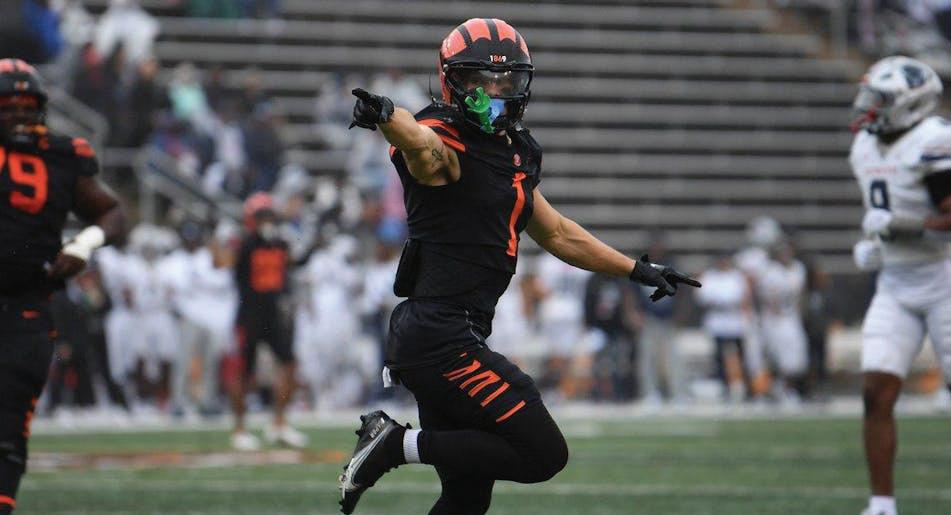
whopping 70 yards, giving Howard possession back on their own 25.
Howard’s offense stalled on first and second downs. On third, Tolbert stepped back to pass and fired one over the head of his intended receiver and right into the hands of senior defensive back Mason Armstead. Armstead’s 30-yard return brought the Tiger offense to the 15-yard line. After an incomplete pass intended for the end zone on third down, Princeton settled for a short field goal to extend the lead to 10–0.
Both teams traded punts on their next two possessions. Howard’s next offensive drive was stalled by a one-yard tackle for a loss by sophomore defensive lineman Rocco Marcelino. Princeton’s offense was also unable to move the ball much and punted once again. Again, Clark pinned Howard deep in their own territory with another good punt. Princeton’s defense then came up with a defensive stop on third and short, forcing Howard to punt from their own 41-yard line.
The snap, however, flew over the head of Howard’s punter Jaydon Green. Green then kicked the ball out the back of the endzone, intending to give up a safety that would have given Princeton two more points. Instead, the officials threw an illegal batting flag on Green for kicking the ball, a relatively rare type of penalty. Instead of giving up the safety, because of the penalty, Princeton’s offense now had possession deep inside the red zone on Howard’s 5-yard line. After two short runs, McAllister ran for his second touchdown of the game, extending the Princeton lead to 17–0.
“I think if you asked anyone at the start of the day today, I don’t think they would have said that I would have been a good runner,” McAllister joked. “But it worked out well today.”
Princeton’s defense continued to hold strong, forcing yet another Howard punt and completing the first-half shutout. A series of penalties alongside a 9-yard completion to senior wide receiver AJ Barber moved the Tiger offense down the field. They eventually settled for a 41-yard field goal scored by senior kicker Jeffrey Sexton, bringing the halftime lead up to 20–0.
The defense continued its dominance early in the third quarter, forcing another three-and-out. A strong punt return by senior running back John Volker brought the ball back into Howard territory. A Howard sack and a fumbled handoff ended Princeton’s offensive drive, but Sexton was again able to convert from deep, nailing a 44-yard field goal, giving Princeton a commanding 23–0 lead.
Now down by 23, Howard’s offense finally showed signs of life. Howard running back Eden James carried four times for 26 yards and Tolbert completed two passes to wide receiver Se’Quan Osborne, bringing the Bison into the red zone. On a direct snap, wide receiver Kasey Hawthorne punched it in with a two-yard touchdown run for Howard’s first points of the game, bringing the score to 23–7.
In response, McAllister completed a 14-yard pass to sophomore tight end Jack Comeau but Princeton’s offensive drive ultimately stalled just short of Howard’s terri-
tory. Clark once again punted the ball back to Howard who took over at their own 15-yard line.
After consecutive short plays and incompletions forced by Princeton’s defense, a questionable roughing the passer call on third down handed Howard 15 yards and a fresh set of downs. From there, Howard’s Jarett Hunter ran the ball for a first down and Tolbert found Hawthorne on consecutive big pass plays. A 9-yard run by Howard’s Eden James moved the chains for first and goal from the twoyard line. Tolbert then capitalized with a rushing touchdown.
With the score now 23–13, Howard’s offense lined up for the two-point conversion instead of the extra point, an attempt to bring the game within one score. Tolbert’s throw toward the front corner of the endzone was undercut by junior defensive back Tahj Owens to maintain the twoscore lead.
“We knew we had to make a statement,” said Owens. “I think that everyone knew that we couldn’t take our foot off the gas pedal.”
Princeton’s rushing offense took over to seal the game. Volker broke off into a 22-yard run bringing Princeton deep into Howard’s territory. Two plays later, junior running back Dareion Murphy dashed through the middle and past the Howard secondary, scoring Princeton’s third touchdown of the game.
“I thought we ran the ball well, the O-line was controlling the line of scrimmage, doing a phenomenal job for us. I mean, they really brought that game home for us,” said
McAllister. After a second down sack by senior defensive lineman Collin Taylor, a failed fourth down conversion by Howard brought out the Princeton offense to take a knee, confirming a satisfying win for Princeton in their home opener.
Princeton greatly improved in several areas after last week’s disappointing loss to Lehigh. For one, Princeton’s special teams raked in points for the Tigers. Sexton and Massick converted on all three of their field goal attempts, and Clark consistently pinned Howard deep in their own territory, averaging 47.2 yards per punt. Princeton’s kick and punt returns were strong as well.
“Coach Surace always talks about the biggest jump that a team will make is from week one to week two. And I felt like we made that jump,” said McAllister.
Princeton’s linebackers also handled Howard’s strong running game, showing significant improvement after last week’s loss where the Tigers gave up four touchdowns to opposing backs.
“I thought our discipline was terrific,” said Surace. “The first game was sloppy, bad snaps, missed assignments … [Today] we were more efficient.”
Next week, the Tigers will open Ivy League play against Columbia (1–1 overall, 0–0 Ivy League) who are coming off a loss to Georgetown.
“Now it’s a whole other level,” said Surace. “It’s a whole other emotion.”
Joe McGonigle is a Sports contributor for the ‘Prince.’
By Hayk Yengibaryan & Alex Beverton-Smith Associate & Assistant Sports Editors
On a rainy Saturday afternoon at Roberts Stadium, men’s soccer (3–3 overall, 1–0 Ivy League) started conference play with an impressive 2–0 win over the Harvard Crimson (0–3–3, 0–1). In the process, the Tigers claimed their first shutout of the 2024 season.
Coming into the season, the Crimson were ranked third in the Ivy League preseason poll conducted by the media. Meanwhile, the Tigers were ranked at sixth.
“A big part of this team and the mentality that we’ve brought into this year is not paying attention to preseason polls, not paying attention to rankings,” senior goalkeeper Khamari Hadaway told The Daily Princetonian in an interview.
“The only thing that we can do and we will do every game is to show up in that moment and put our best out there. Whatever team is in front of us will have to deal with that. Our mentality is to go at every team we play.”
The Tigers dominated the game from start to finish, finishing the
game with a staggering 11 shots on goal in comparison to the two for the visitors. While Crimson goalie Lucian Wood made a career high nine saves, it was not enough as junior forwards Daniel Ittycheria and Will Francis both found the back of the net in front of the 646 fans in attendance.
The Tigers started off the game emphatically with a composed strike after a mistake by a Harvard center back led to Ittycheria opening the scoring for Princeton.
“The team had a great mentality to start the game, came out with a lot of energy, and scoring the first goal so quickly certainly helped,” head coach Jim Barlow wrote to the ‘Prince.’
“We’ve been trying to emphasize defending well individually and collectively for 90 minutes and this was our most complete team performance,” Barlow continued.
It took just 90 seconds for Princeton to open the scoring as Harvard’s goalkeeper stood powerless watching the ball sail past him. This goal took Ittycheria’s tally up to four for the season and he leads the Tigers in goals and points scored.
Off to a flying start, the Orange and
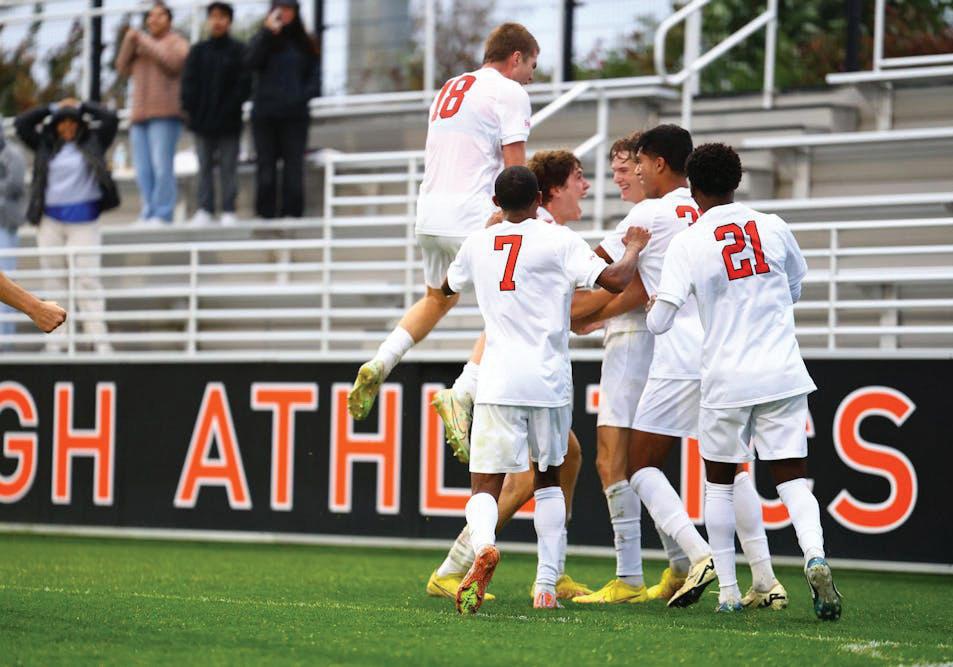
Black kept dominating the ball and taking shots against the Crimson defense including two shots that hit the post from junior midfielder Jack Jasinski and Francis.
Chances soon started to pile up for the Tigers as the 21st minute of the game saw a shot from sophomore forward Kevin Kelley get blocked before a rebound came back to junior midfielder Gabriel Duchovny who forced a save off the Harvard keeper.
The weather in the first half was an interesting factor, with heavy rains affecting the quality of both teams on the pitch, leading to rough fouls committed by the Crimson. The visitors got two yellow cards in an 11 minute span displaying their frustration with the multiple Tiger opportunities on their goal.
“Last year, we got hit pretty hard first game of the season against Dartmouth in similar conditions,” Hadaway added. “This year, especially in the offseason and before coming to school, we’ve trained in worse conditions to prepare for another game like that. We were much more prepared this time. Rain or shine, we know we were gonna get the job done.”
In the next five minutes, attempts came from Francis and sophomore midfielder Liam Beckwith, forcing more saves from Wood. Despite plenty of attempts and five shots on target as the half ended, the Tigers couldn’t find another goal.
The Crimson came to play in the second half, however, as they forced an acrobatic jumping save from senior goalkeeper Khamari Hadaway just two minutes in.
“When it happened, I trusted my years of training and what I’ve been taught,” Hadaway told the ‘Prince.’ “I have a lot of trust in myself and in the training I’ve had over the years.”
As the game progressed, it became more scrappy with tensions rising. After the teams traded shots, in the 73rd minute Francis got the ball and surged forward. He ran through four players weaving into the box before he slotted
the ball home in the bottom right corner doubling the Tigers’ lead.
The Tigers saw out the rest of the game in relatively comfortable fashion despite its physical nature. There were plenty of opportunities for a third goal with attempts from Ittycheria, Kelley, and first-year midfielder Kristian Kelley, but ultimately the game ended 2–0.
“It was an effort from the entire group to get the first clean sheet for the year,” senior defender Issa Mudashiru told the ‘Prince.’ “The way our midfielders covered ground and broke up plays in the middle of the park all game long won us the clean sheet.”
“It would take a full 90 minutes sustained effort to come out of the game with a result. Every moment matters in Ivy League games. These games are gritty, emotional, and pandemonium, but the team that fights to stay locked in for the entire match is the team that wants it more and the team that often wins,” he continued.
One of the bright sides for the Tigers has been the play of Issa Mudashiru. The Maryland native was a secondteam All-Ivy selection in 2021 before two injury riddled years. Mudashiru is one of the captains for the team this year and has been an integral part of the Tiger’s back line.
“We’ve had a number of very talented players go through injuries in the past couple of seasons and at the start of this season, and Issa is someone who has been through a lot,” Barlow noted. “Hopefully [Mudashiru] can stay healthy this fall as he is not only a very talented player but also an important leader. Issa and all of the defenders did a great job on Saturday keeping some talented Harvard forwards from scoring.”
For Mudashiru, being able to step on the pitch and play the sport he loves is not something he takes for granted.
“’We get to play soccer today’ is a phrase that I picked up from one of our coaches, Sam Maira, and I often repeat it during warmups in practice,” Mudashiru noted. “It’s a constant reminder to me and the rest of the guys
how lucky we are to have the opportunity to kick a ball around.”
“The tax that an injury can have on a player’s wellbeing and mental health can be extreme, and I know for me personally after a dream start to my Princeton career in 2021, not being able to play soccer at the level that I knew I could play in my sophomore and junior years was frustrating and frankly exhausting emotionally,” Mudashiru continued.
Next up for the Tigers will be two games this coming week. On Tuesday, the Orange and Black will host the Monmouth Hawks (4–0–5, 1–0–3 Coastal Athletic Association) in another league contest. Following the contest, the Tigers will travel north to Providence, Rhode Island where they will take on the Brown Bears (3–4–1, 0–1–0).
“I think it’s gonna be crucial that we rely on our depth and we rotate throughout our squad especially considering that we have so much quality in all our positions,” Hadaway responded when asked about the challenge of a midweek game and having three games in a span of a week.
The game against the Hawks will be a great test for the Tigers as they recently beat then No. 12 ranked Hofstra. Looking to build on the momentum against the Crimson, the Tigers will look to win back to back games for the second time this season.
The storyline against the Bruno will likely be interesting as well, as the Tigers will look to start conference play with two wins for the first time since their undefeated league season in 2021. Barlow ended by noting, “We know we are a much better team now than we were a month ago when the season started, but we realize we need to keep improving and bringing the kind of effort we displayed Saturday every day.”
Hayk Yengibaryan is an associate Sports editor for the ‘Prince.’
Alex Beverton-Smith is an assistant Sports editor for the ‘Prince.’
By Lianne Chapin Contributing Archivist

In the fall of 1970, students returned to a Princeton forever changed after the events of the previous semester. Members of the Class of 1970 wore white armbands at their Commencement in the wake of the Kent State Massacre and a University-wide vote to strike in response to the U.S. invasion of Cambodia during the Vietnam War. Over the summer, President Nixon had established the President’s Commission on Campus Unrest to study the escalation of violence at Kent State and other institutions.
Princeton was also facing a proposed inquiry into its tax-exempt status following protests against its military ties. In addition, fall break had been introduced as an opportunity for students to participate in political organizing
free from the pressures of classes before the November 1970 midterm elections.
Navigating an unprecedented fall semester, University President Robert Goheen ’40 convened a conference of alumni and students to “clarify to alumni the university’s problems and to ask their counsel” and to discuss the community’s steps forward with the goal of “foster[ing] ‘an understanding on all sides.’” Students, trustees, administrators, and alumni all contributed to the conference, engaging in lengthy dialogue about the University’s finances, community, degree of political neutrality, and student attitudes.
Alumni also voiced concern at the “lack of information [they] received on campus developments” after they were not consulted in the vote and movement to strike. Another article published later
notes that the conference followed a dramatic fall in alumni participation in the previous year’s Annual Giving campaign.
In the article, then-director of Annual Giving Joseph L. Bolster ’52 commented that “from the standpoint of understanding, the conference should be beneficial to the campaign,” suggesting that the intentions of the conference were to “ask for alumni advice” but also to ensure that the dip in annual giving would be corrected by offering alumni an opportunity for increased involvement.
In a time when reactions to campus protests are again on the University’s collective mind, Calla Schultz ’24, a recent alumna, is grappling with her position as a recent graduate.
“Now as an alum, I think that alums are most looked to for their capital,” Schultz told the ‘Prince.’ “And as a young alum, I don’t re-
ally have capital.”
The 2023–24 annual giving campaign was one of the ten most successful in Annual Giving history, so it is safe to say that alumni continue to finance Princeton’s future despite growing polarization on campus.
While Princeton’s coffers are heavier than when they were in 1970, alumni remain an influential part of the Princeton community. An article on alumni relations quotes former Chair of the History Department Lawrence Stone’s remark to conference attendees that “in order to survive, Princeton will need the hard work and support of all the members of the university community, people who should realize what a valuable institution has been entrusted to their care.”
Lianne Chapin is a contributing archivist for the ‘Prince.’